ALLIGATOR
BEHAVIOR page 5j: BABY
ALLIGATORS --page 10 Alligator nests and babies page 1
2
3
4
5
6
7
8
9
11
12
This
page
was born 12/14/2022. Rickubis designed
it. Last
update: 03/21/2023
Images
and
contents on this page copyright ©2023 Richard M. Dashnau
Most of these were
posted on the RICKUBISCAM
page first, then moved here.
From Brazos Bend State Park
on 09/25/2022 to
12/04/2022:
For 20 years, I've been going to Brazos Bend State Park almost
every week.
I've seen many seasons and conditions at the park.
And, of course,
spent lots of time watching alligators (and many of the
other
animals that live there). I think this year I had my first
chance to
get a better look at the relationship between a
pod of baby alligators
that had to relocate and the environment it lives in. We had a
very dry summer, and
that caused big changes in the habitat. By chance, I happened to
collect a number
of
observations of a single pod from September through December 4th
(I'm
writing this on 12/9, and there may be more to come.).
One
of my most important lessons involved the relationship of some
of the
wading birds (mostly Great Blue Herons) and the pod. For years,
I've
read about, and described, how
the baby gators are at risk from many
predators, including herons. But, during all the years
standing
on the trail, and watching the activities of the pods-while also
watching the foraging
strategy of the Herons-I began to
wonder how the herons actually find the babies. The Herons (and
many
other "wading birds") generally do what I've described as
"prospecting"
for prey. That is, they usually don't fly over an area to spot
prey and
attack it. They'll land at a good spot, and then start walking
slowly
while examining the area around them.
When they find a target, then
they'll slowly stalk it until they get within striking
distance--and
make the stab. Using that process alone, the odds against
a Heron
finding a pod
of gators seemed pretty low. The babies are well
camouflaged, and of course the mother is usually
around--although I've
seen mother gators go off and leave their pod for
20 minutes or
more. But this summer I saw multiple examples of wading
birds
hunting near a pod of babies, and also got to see the mother
warn off
the birds that got too close.
The mother's protection was mostly
successful...but that's at the end of this story.
So...let's go.
I've put together an 11-minute long video that summarizes this,
with
the added
attraction of video clips showing some of the action. That
11-minute video is here.
Part
1 of 9: On 09/25/2022
Various
park visitors mentioned seeing baby alligators and their
mother
near the concrete culvert by the 40 Acre Lake Observation
Tower. When
I
went back
there, I couldn't find the babies at first, but I
did find
a Great Blue Heron. After it stalked away a few yards, I heard
some
baby alligators chirp. I still couldn't see them. I
stepped
away from the
culvert, and the Heron stalked back. Another Great Blue
Heron appeared and chased off the first one. I waited, thinking
that
I'd soon be observing some drama involving a Great Blue
Heron and
some baby alligators. But, the second Heron moved closer to the
bank,
and I couldn't see what it was up to. (There was also brief
action with a hawk and some bullfrogs
described on this page. ) I
discovered where
the
mother alligator was when she surfaced and rushed at the
Heron--which flew away. Later,
I realized the the Bullfrogs might
have
been flushed out of the water by the Great Blue Heron that
I'd
lost sight of below the bank. Also, the Hawk (which was also
hunting in the area) was another potential threat for the baby
gators.
The baby gators would have crossed the trail in the same area
that the
frogs had. A Hawk could have snatched up a baby gator just like
it
snatched the frog. The images below
are from a bit later, and
the babies started to appear. I was surprised to see so
many pop
up. Right from my first sighting of this pod, Great
Blue Herons were in the immediate area,
and possibly searching for the babies.
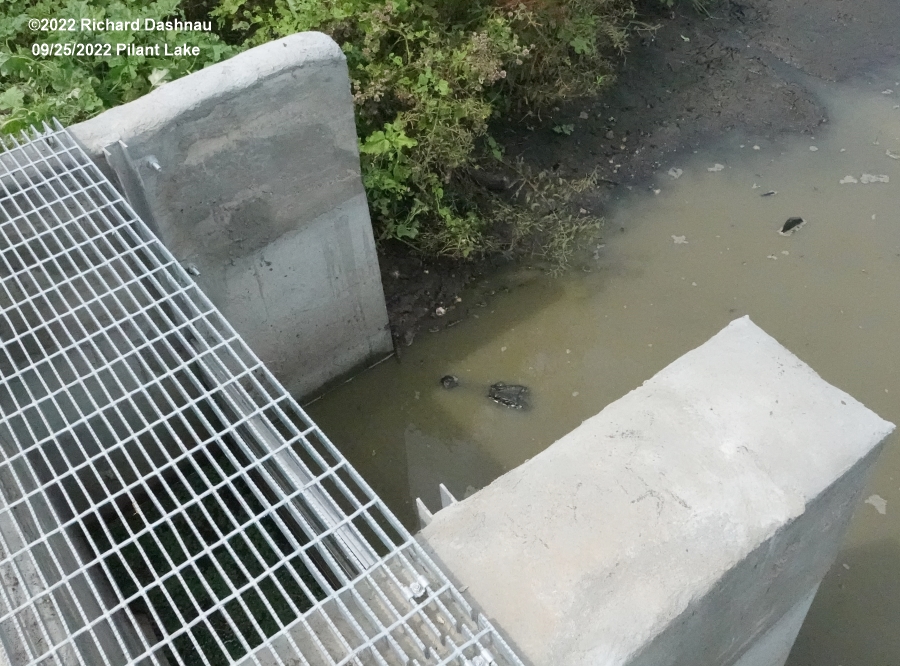
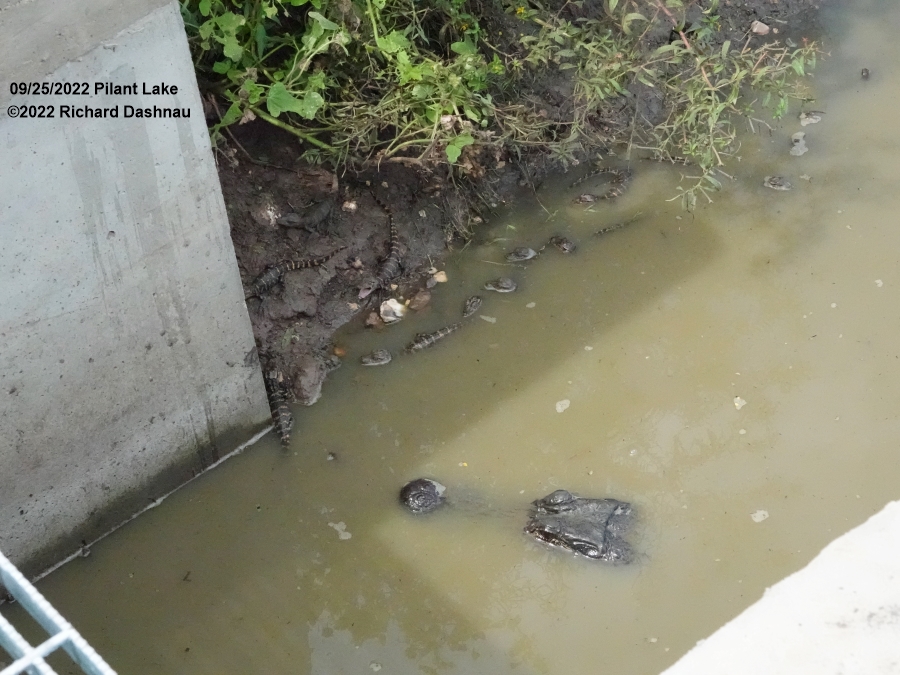
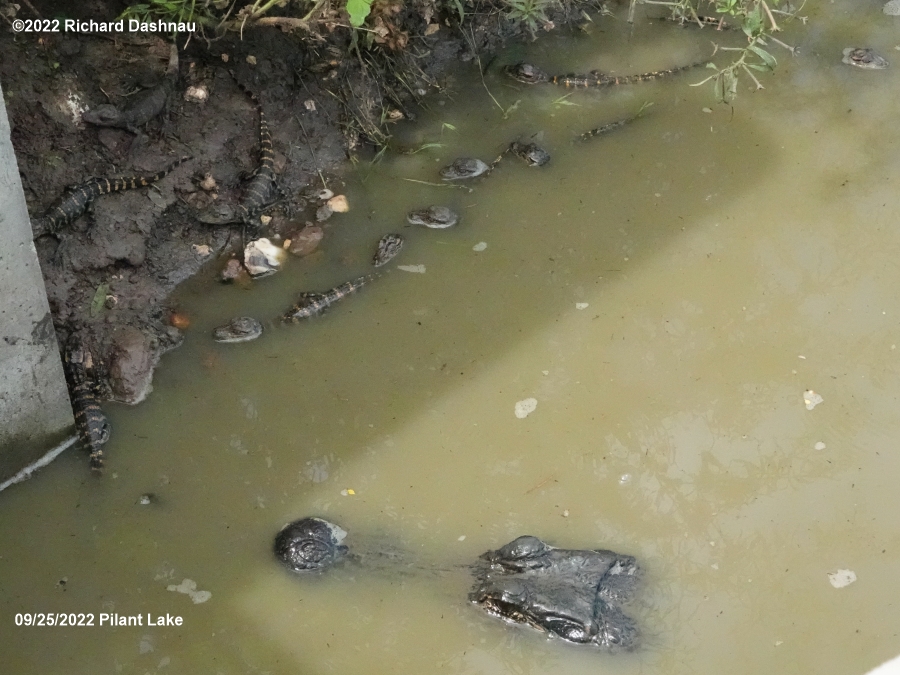
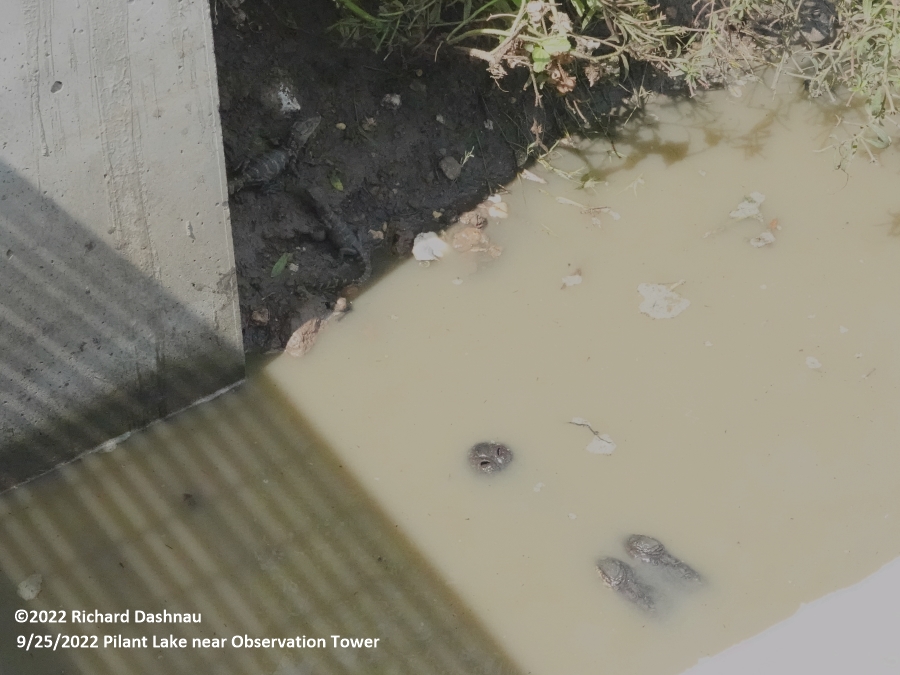
Water
by the new culvert/dam was already quite low, and clouded with
silt stirred up by the animals moving in it.
When I looked for the babies the first time, they could
have been hiding under
the water right
there. As these two series of pictures show; the mother was
easily
hidden, too. If she decided to just expose her nose to
breathe,only the nasal valves opening would give it away.
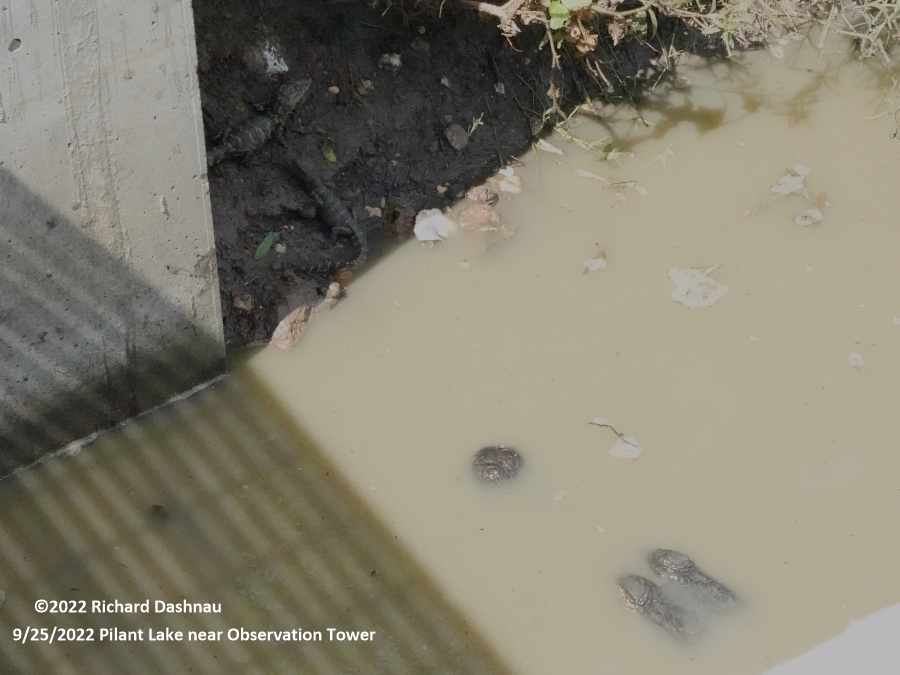
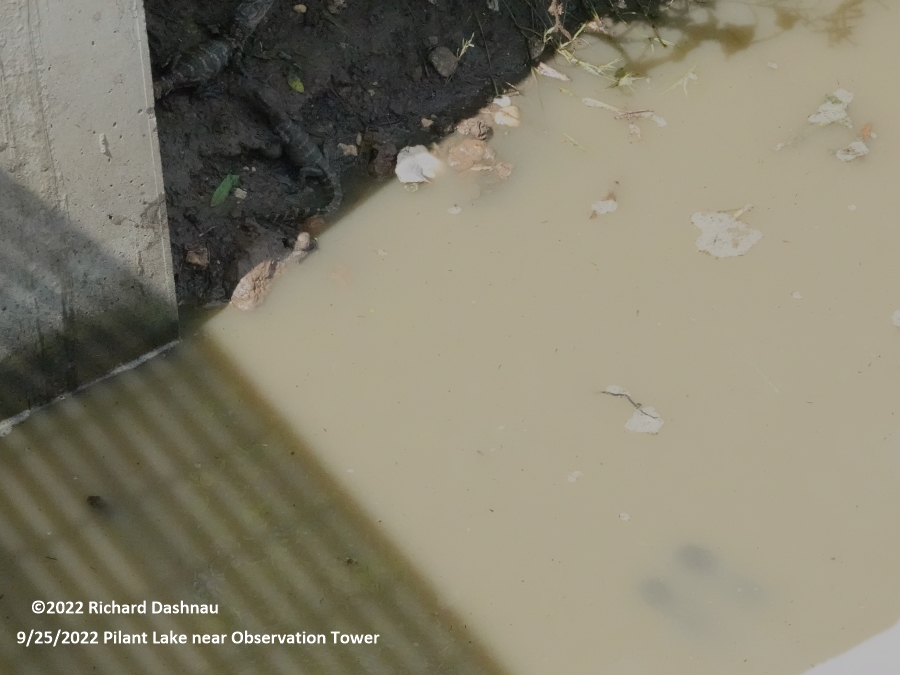
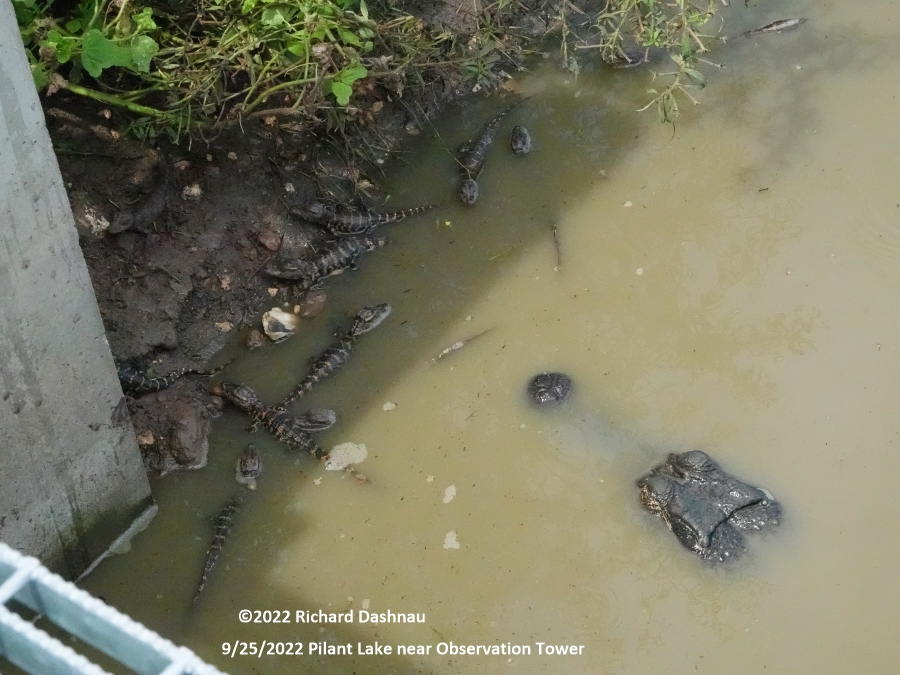
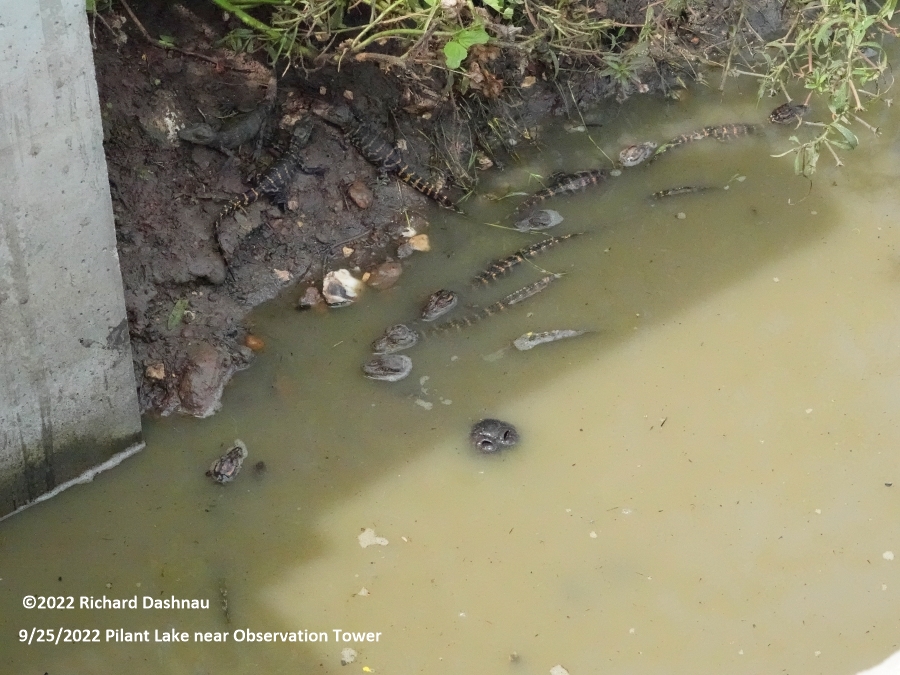
A
very good demonstration that shows that a mom gator could be anywhere near the pod.
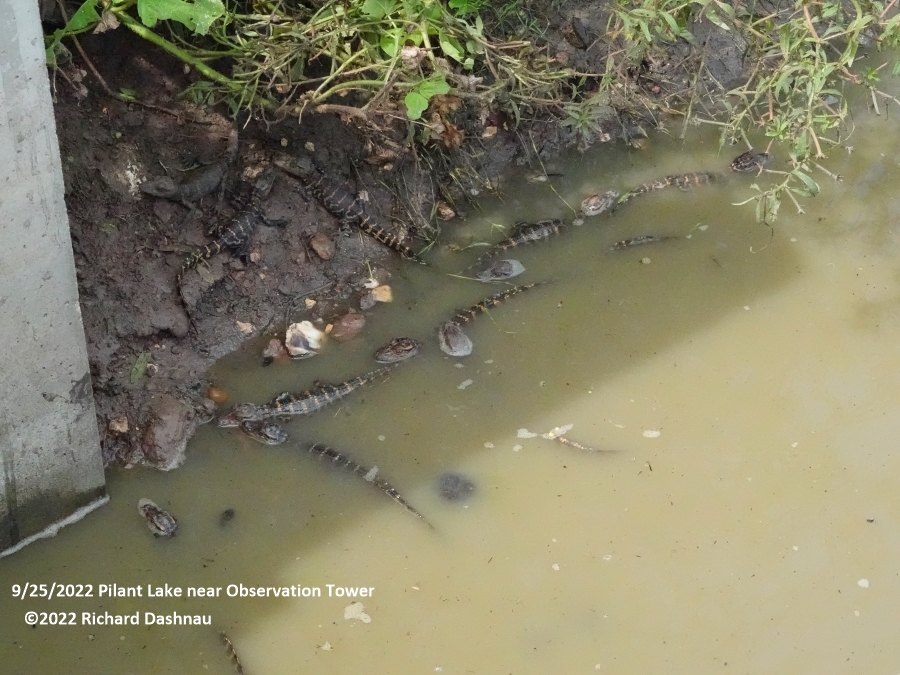
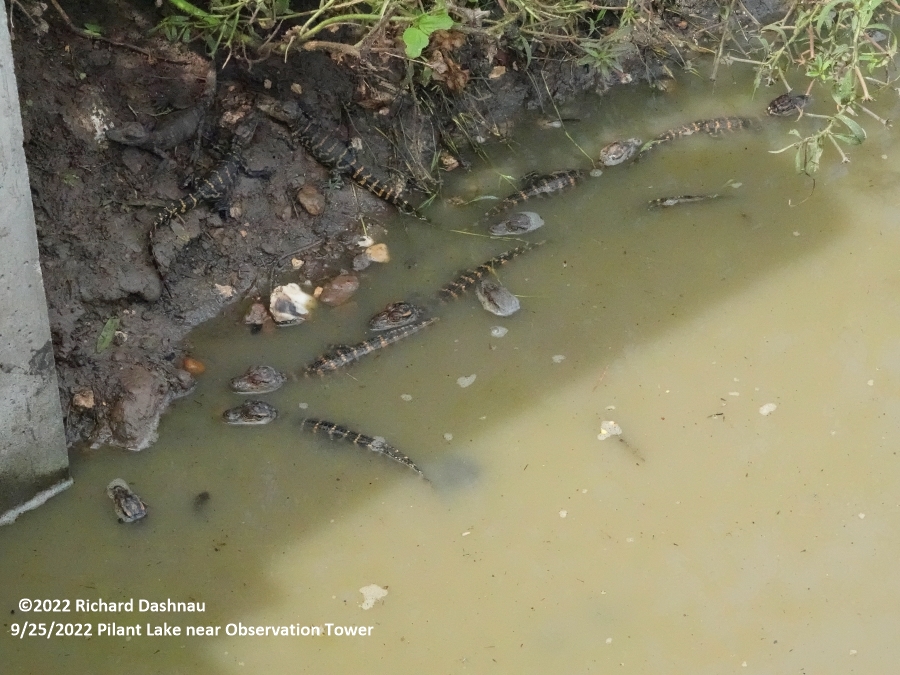
Part 2 of 9: On
10/02/2022
(a
week
later), the pod had apparently moved across the trail, into
Pilant
Slough but still close to the tower. But, what I saw
first thing
that morning was an
alligator chewing on the carcass of a
Nutria. I thought I could hear a chirp or two, but no babies
were
visible. I watched the alligator-which I'd thought was the
mother
because it was
near the babies. I had assumed that a mother
alligator would chase other alligators away. But comparison of
pictures
taken over the summer shows that there was at least
one other
alligator that stayed in that area along with the mother with
pod. This
"2nd gator" was at lmuch larger than the mother. The
alligator carried the carcass into the weeds
where it
was hidden from me. After a while, It returned to the
water
without the Nutria in its jaws. Examination of that last
image
seems to show a bloated alligator, so I think it
had swallowed the carcass instead of leaving it in the weeds.
The
babies began to appear after another couple hours.
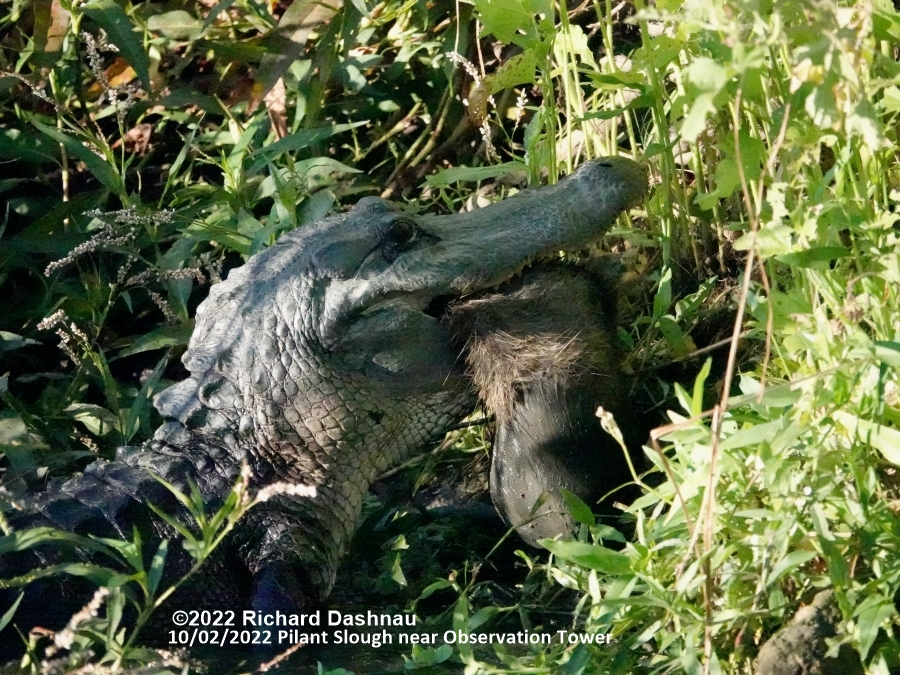
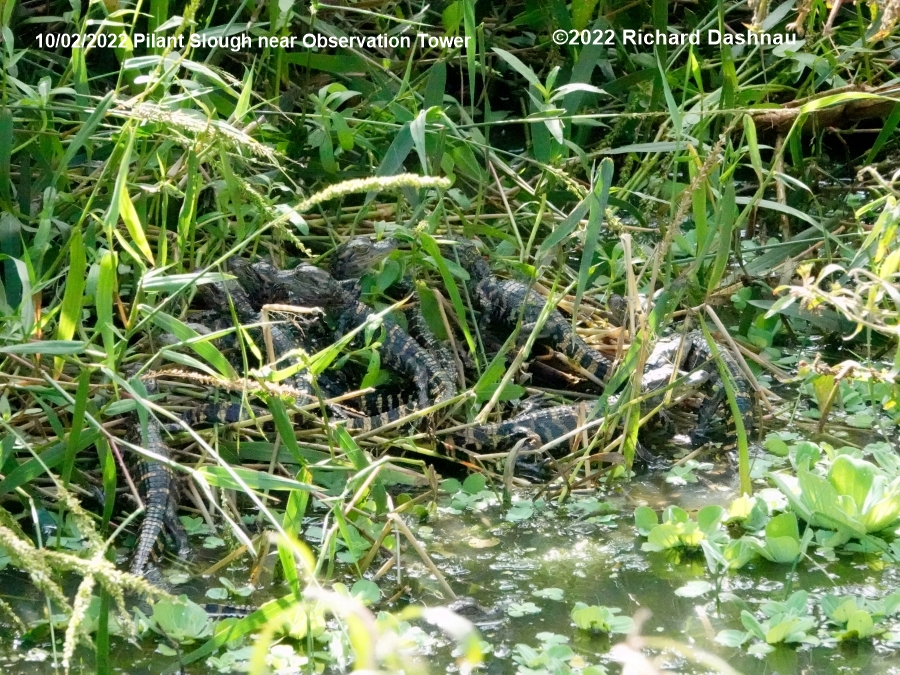
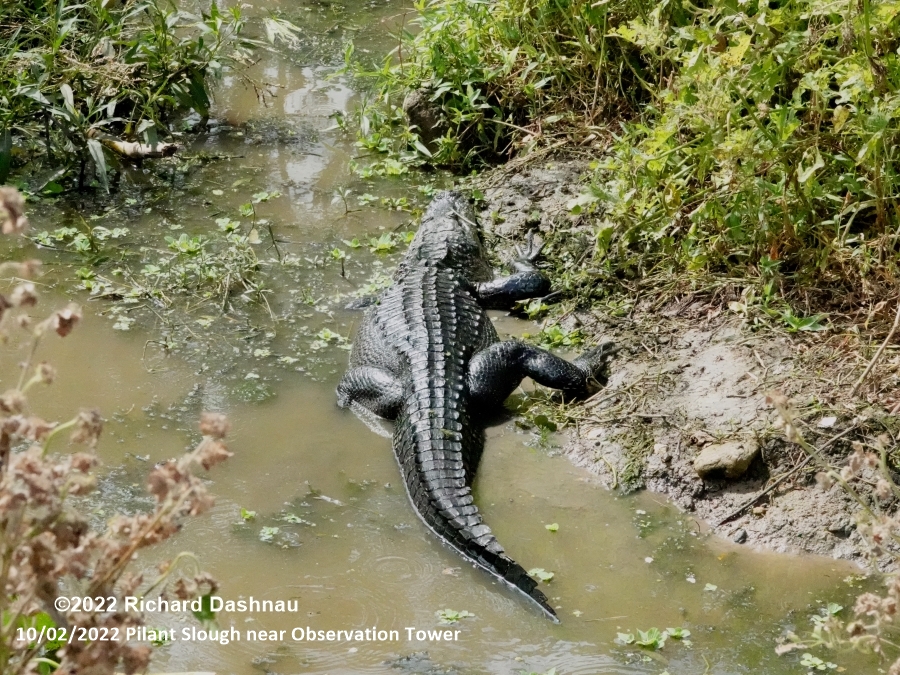
Part 3 of 9: On
10/16/2022
there was a Great Blue Heron stalking the area. I did not ever
see baby
gators that day, but I could hear an occassional chirp. The
mother was
visible. The heron
quietly stalked through the heavy growth (shown in the
pictures!). Mother gator slowly moved into the weeds. There
was
a rustle of quick movement, and a low splash. The heron
turned
and
stalked away from the sound. Somehow, the mother was
aware of
the proximity of the heron (in all that cover) and and moved
to chase
it off. This interaction was so subtle I didn't capture it,
even
though I was shooting video. Later, the mother moved onto one
of the
exposed mud banks (There's one to the left, one to the right
in the
first image).
Then the other gator appeared, and got onto the bank with
her! The "2nd gator" moved slowly, but not timidly, to get
onto the
favored basking spot. Everything I have read about
alligators
indicates that they do not
bond as a pair. I cannot tell why this mother was so
tolerant of
the presence of another alligator. Could the babies be a
combination of 2 pods? Or could it be
because the 2nd gator is larger, and the mother couldn't make
it leave? The alligators wouldn't say.
(If you examine the eye closeup, you can see me in the
reflection)
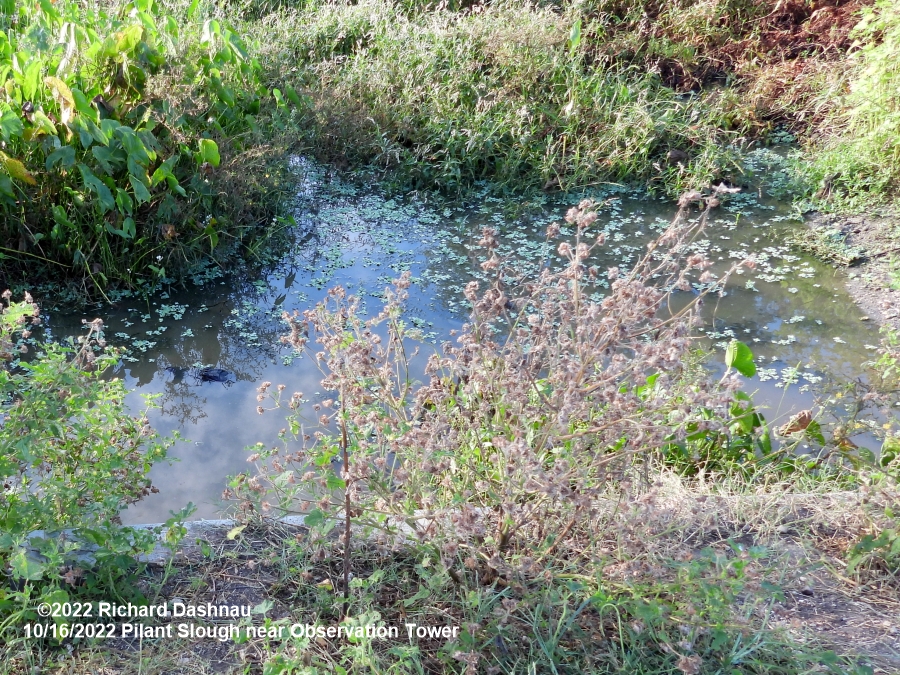
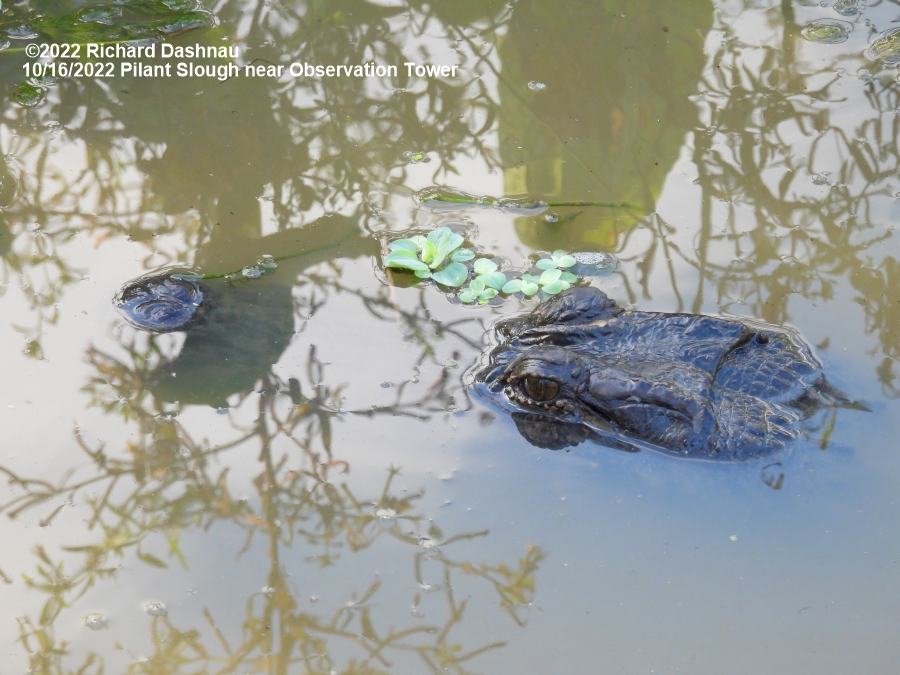
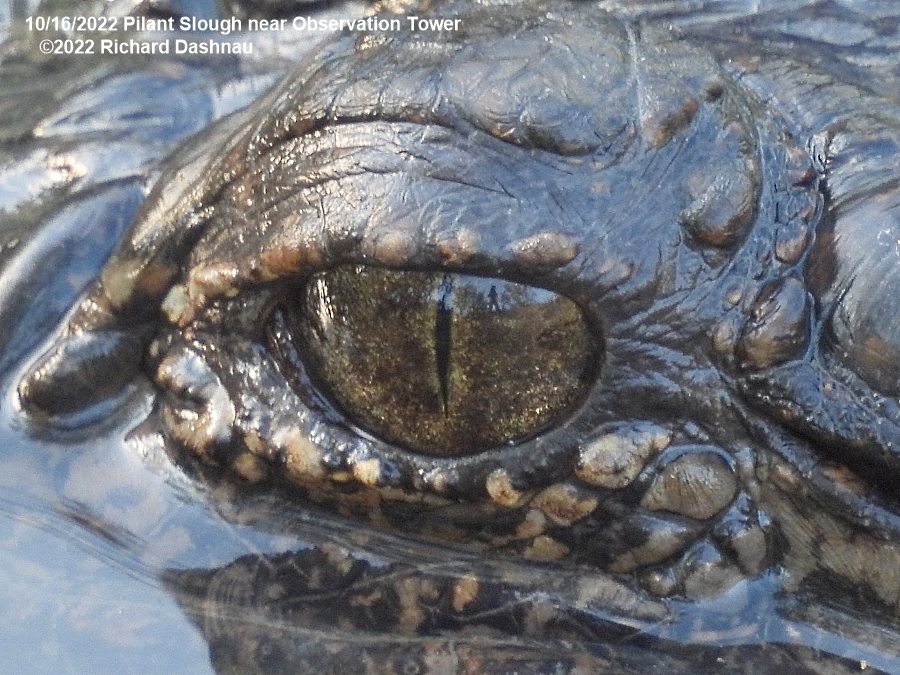
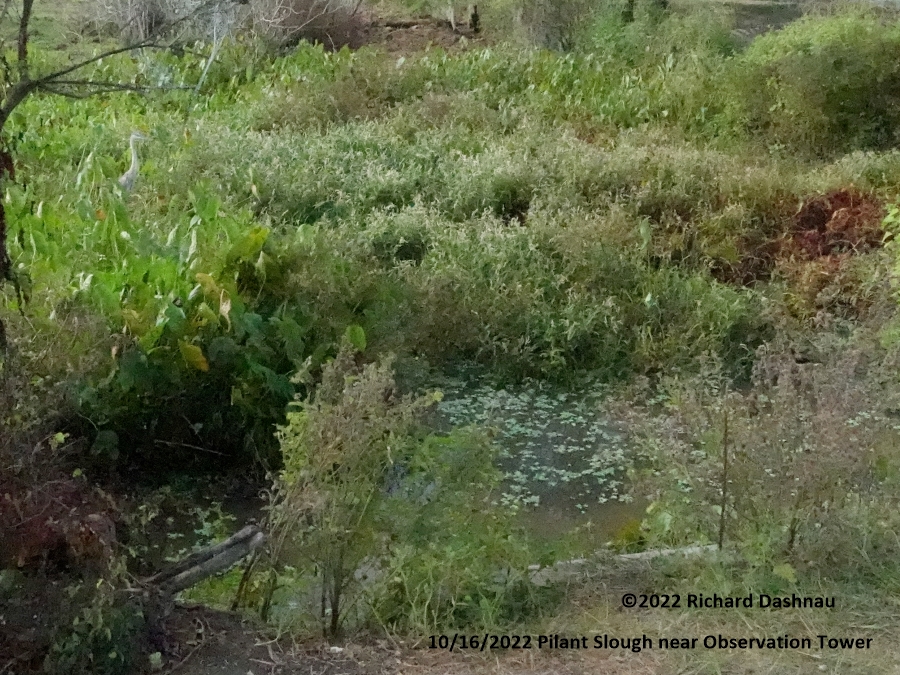
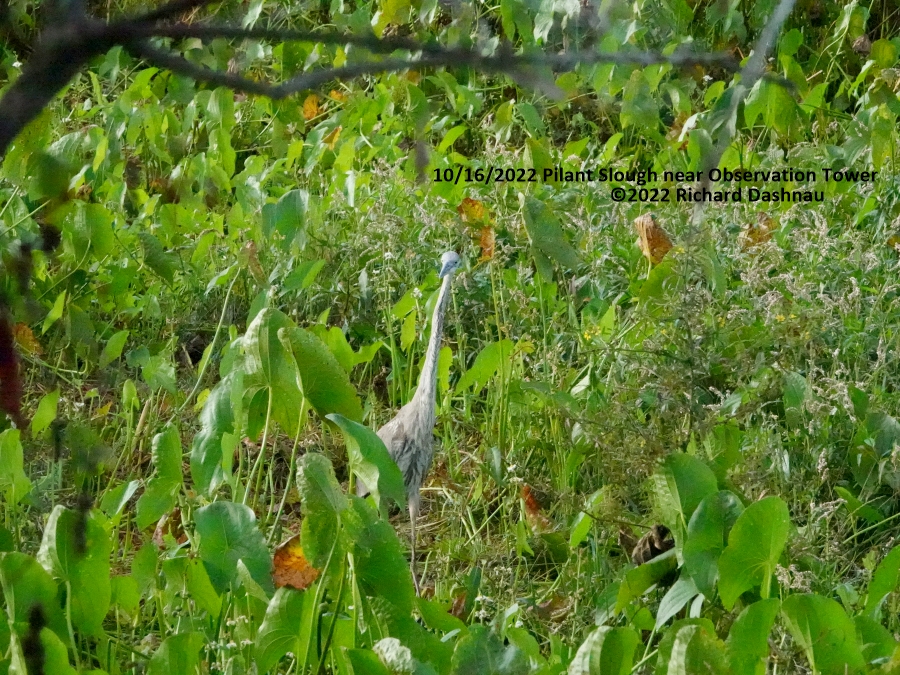
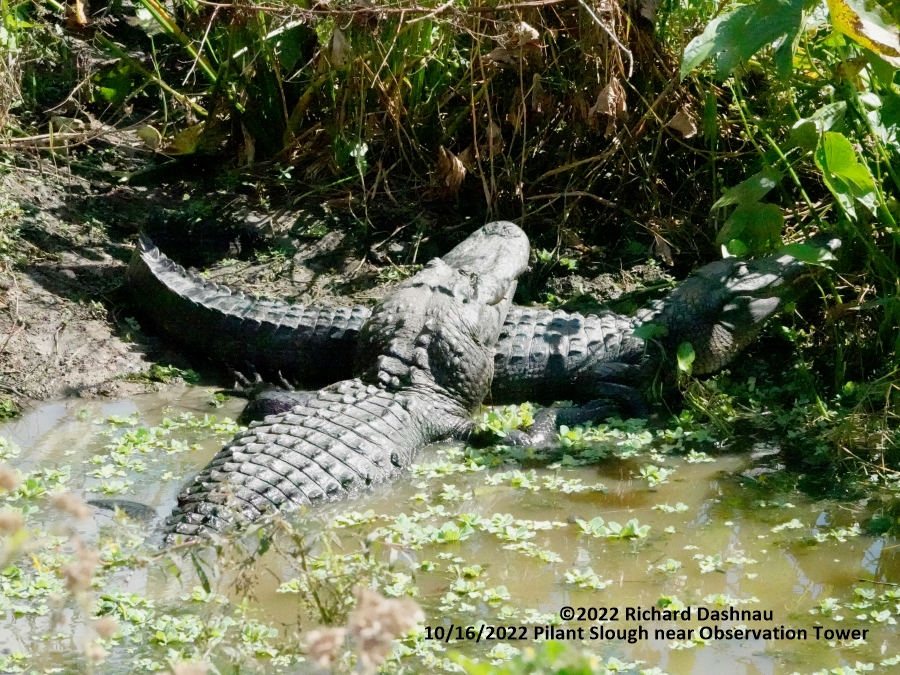
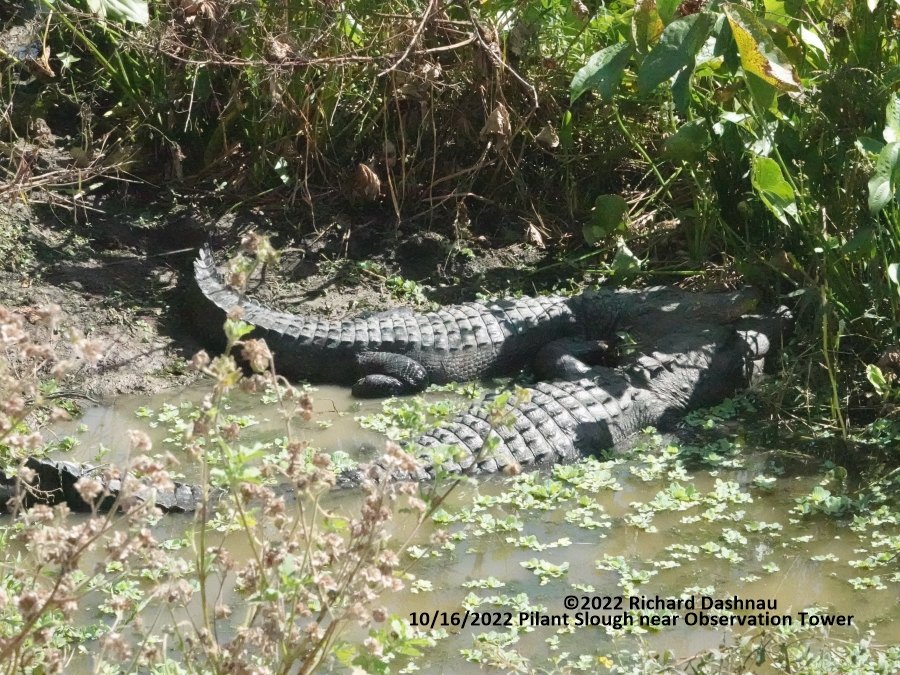
Part 4 of 9: On
10/23/2022
I didn't see any predators that would threaten the pod. But
that day,
the alligators joined a chorus of bellowing. Alligators
bellowed in 40
Acre Lake
and one of the alligators bellowed from near the pod.
Although the alligator that I saw bellow seems to be a female,
I
believe that this is not the smaller one, which
seemed to be the
acting guardian of the pod. The baby gators showed no fear of
the "2nd
gator", and one seems to be crawling over its snout. At the
time, I
still
assumed that the babies would stay near the mother--which I
thought was
the smaller adult alligator. Some time after the bellowing,
more of the
baby gators appeared, or
were easier to see as the quality of the
light changed. I have a lot more detail about the
many
events on this day (and why I think the bellower shown here is
female)
on another
of my pages. There's also an edited video showing the events.
After reviewing this material for this report, I think
that there were two females, and if not
two
separate pods, possibly a merged group of two pods. From what
I saw,
the larger alligator ("2nd gator") didn't "protect" the babies
like the
smaller one did.
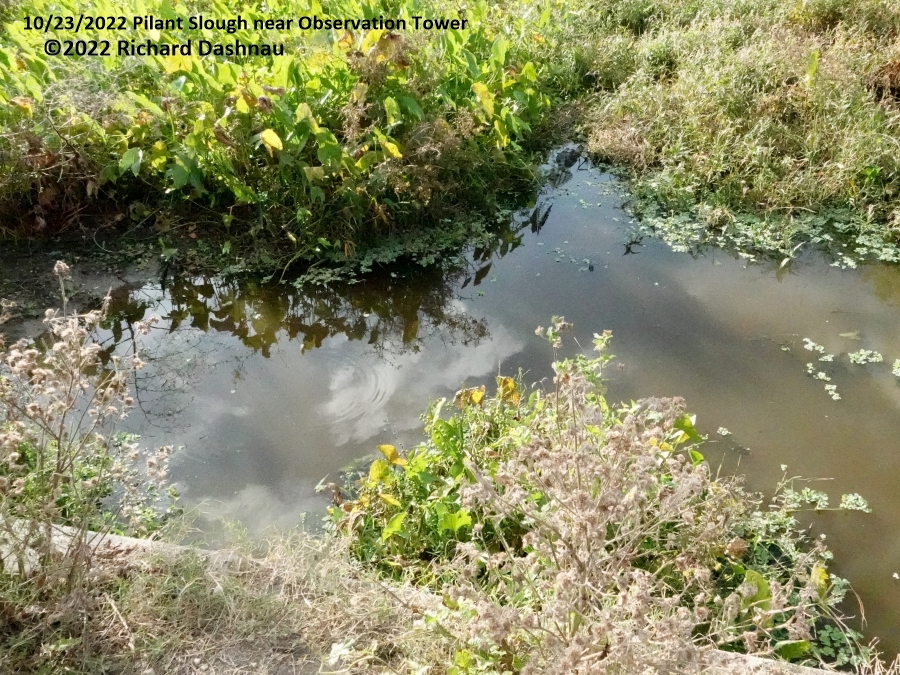
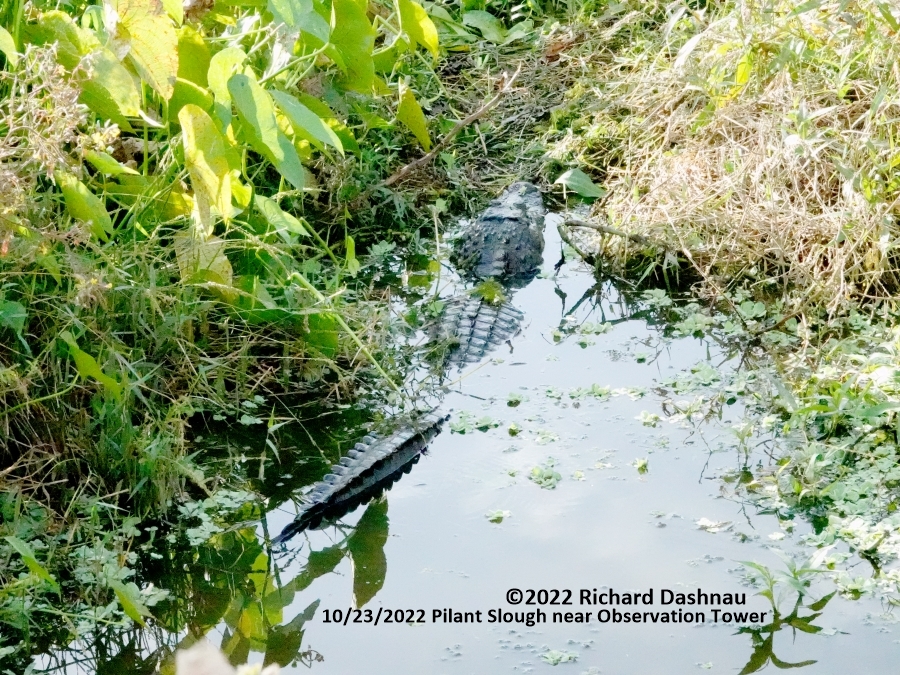
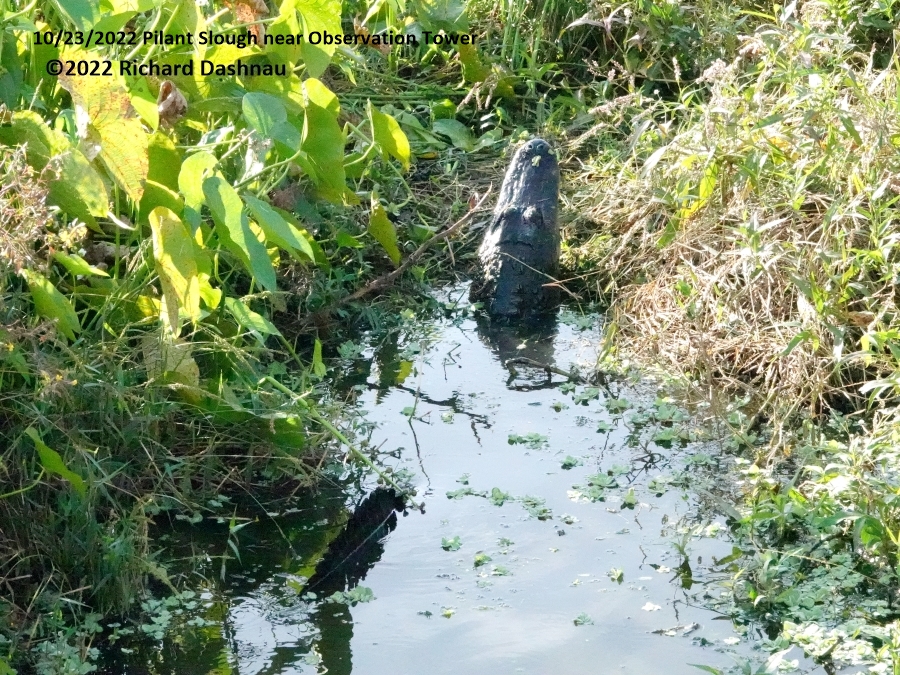
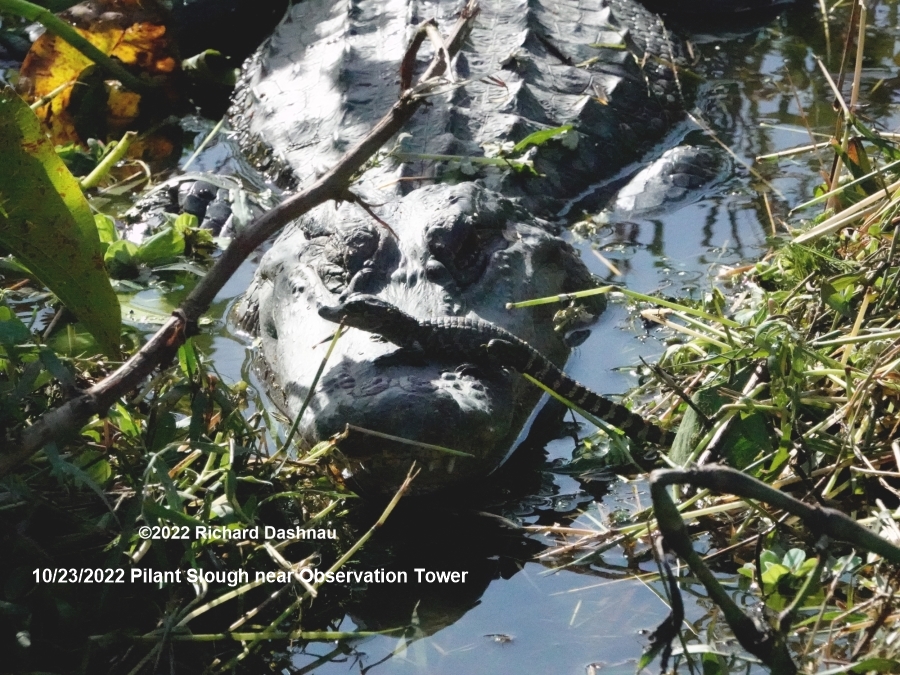
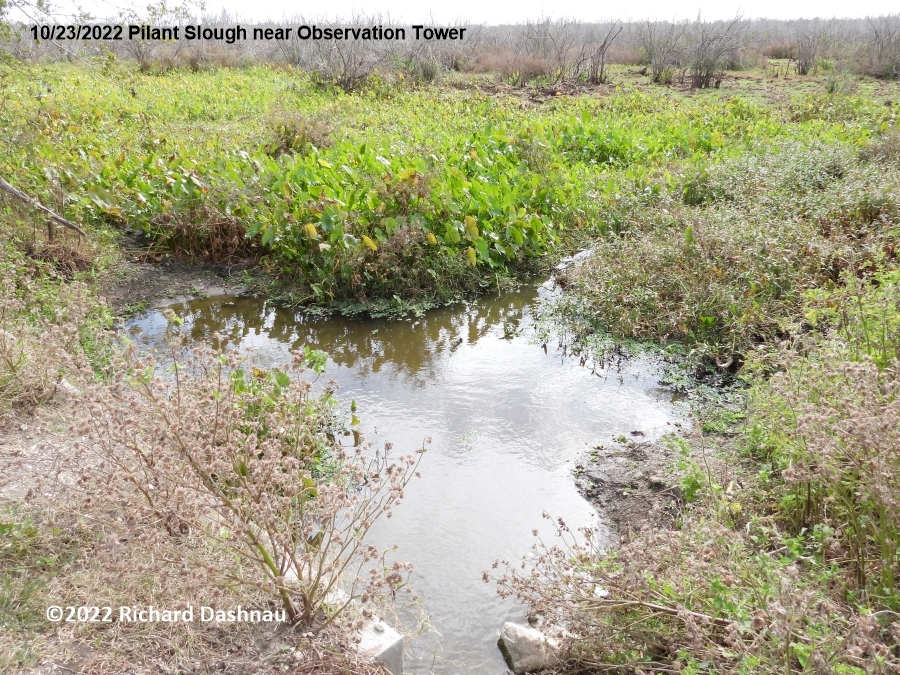
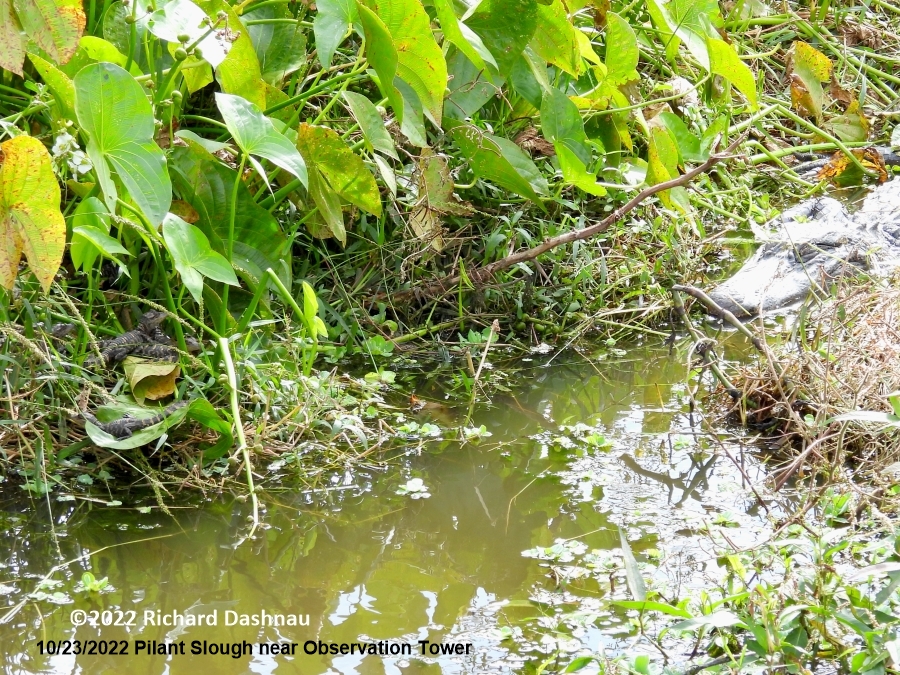
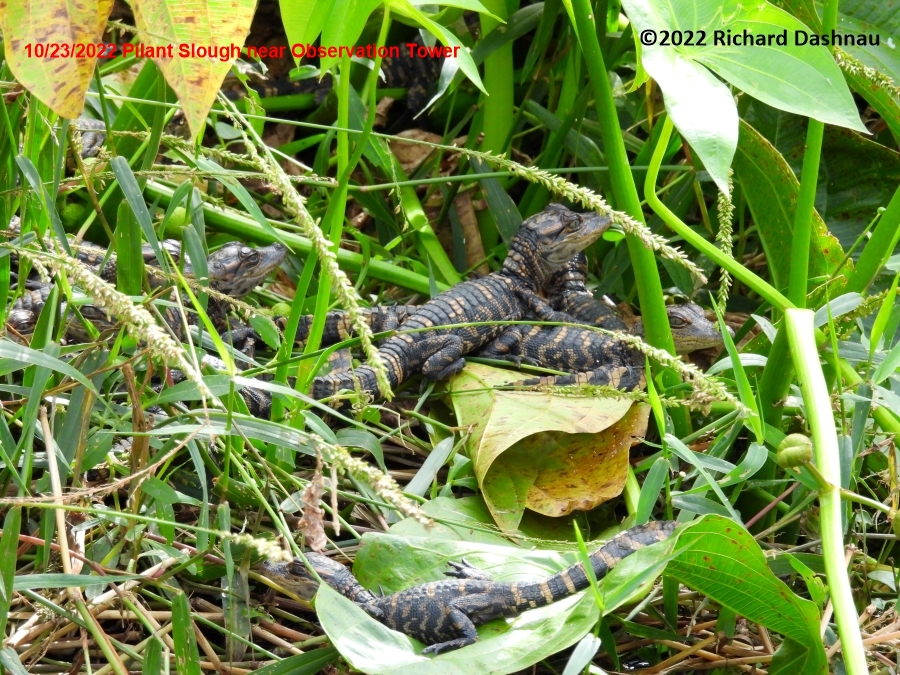
Part 5 of 9: On
10/30/2022
I didn't spend as much time near the pod. I stayed long enough
to get
some images of two American Bitterns hunting in the area.
I think
this is
significant
because a Bittern has been photographed capturing and eating a
baby
alligator at BBSP. But, since this area (and going down Pilant
Slough
going East) had
the available water in that vicinity, most of the
wildlife would be gathered there anyway. It's possible that
the
Bitterns might have also been searching for the pod, but the
Great Blue Herons consistently worked near it.
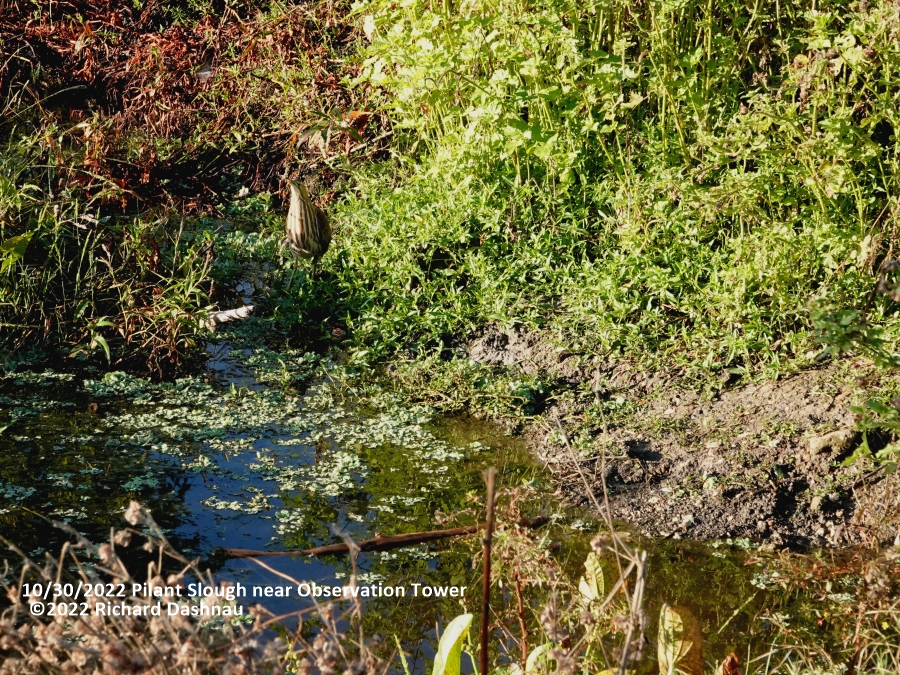
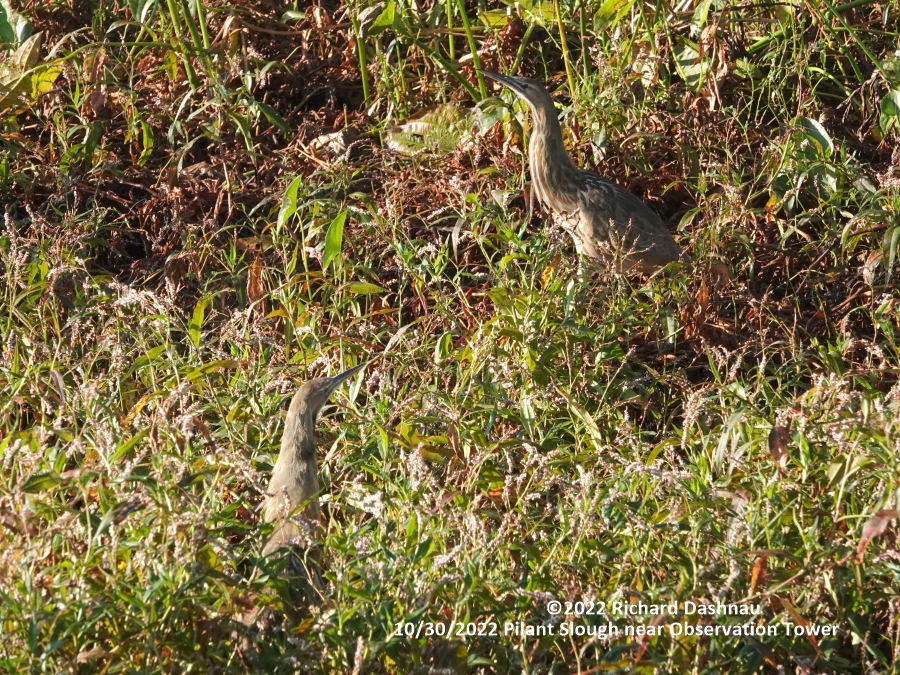
Part 6 of 9: On
11/06/2022
the pod had moved about 30 yards East, and about 10 yards
further out. As usual,
more babies appeared as the day continued. A Great Blue Heron
foraged
nearby,
but stayed in the area where the pod had been. I didn't see
the Heron
get near the pod. But it did capture a Mississippi Green Water
Snake in
the same area. I think that the Herons
were aware that a pod of baby gators was in the area
during the weeks since September. I have more
images of the pod on this day on another of my pages ; there are more
pictures of
the Heron with the snake on this page.
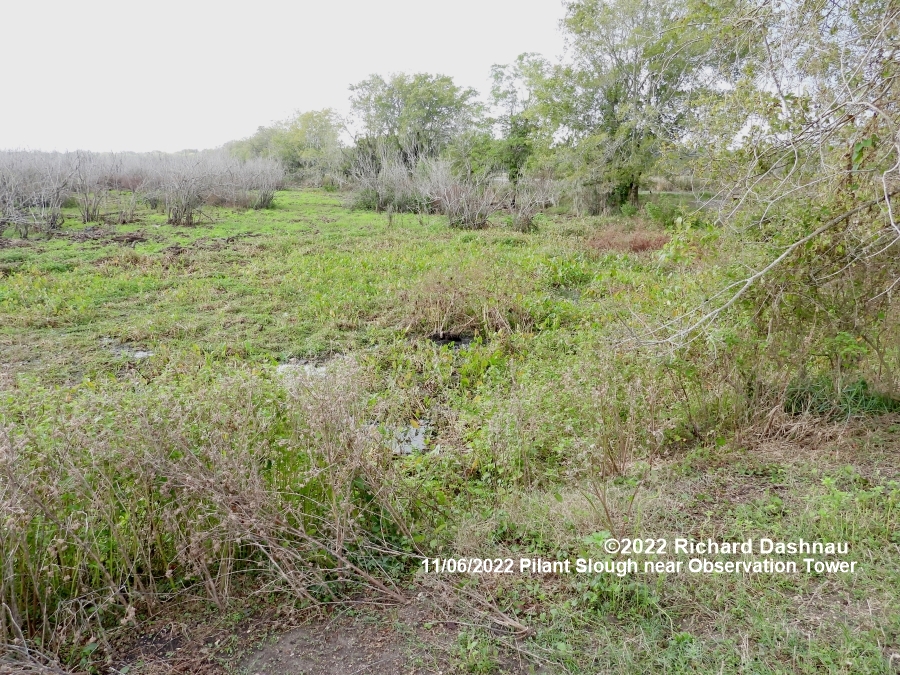
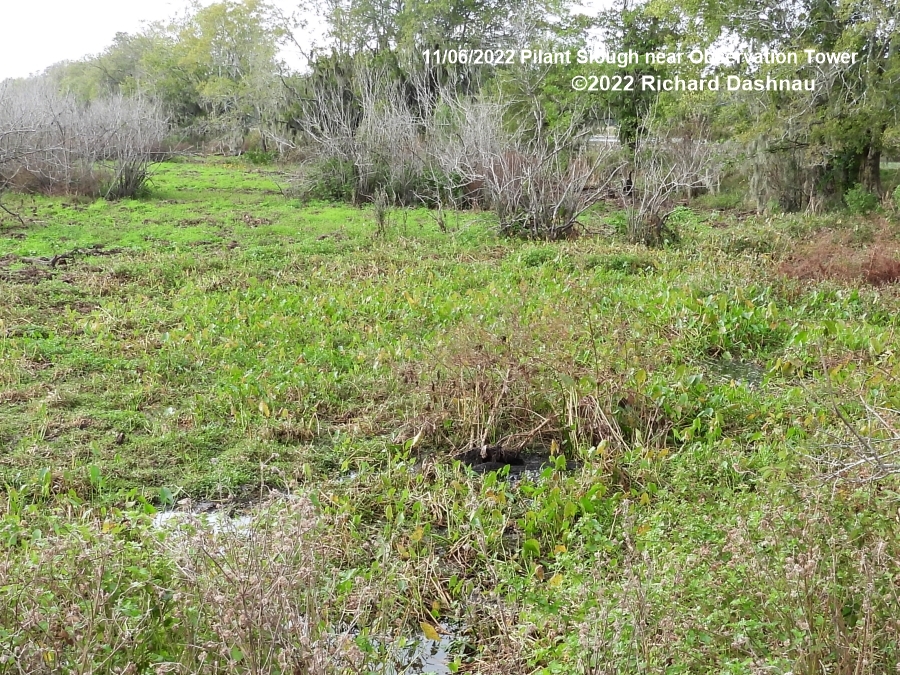
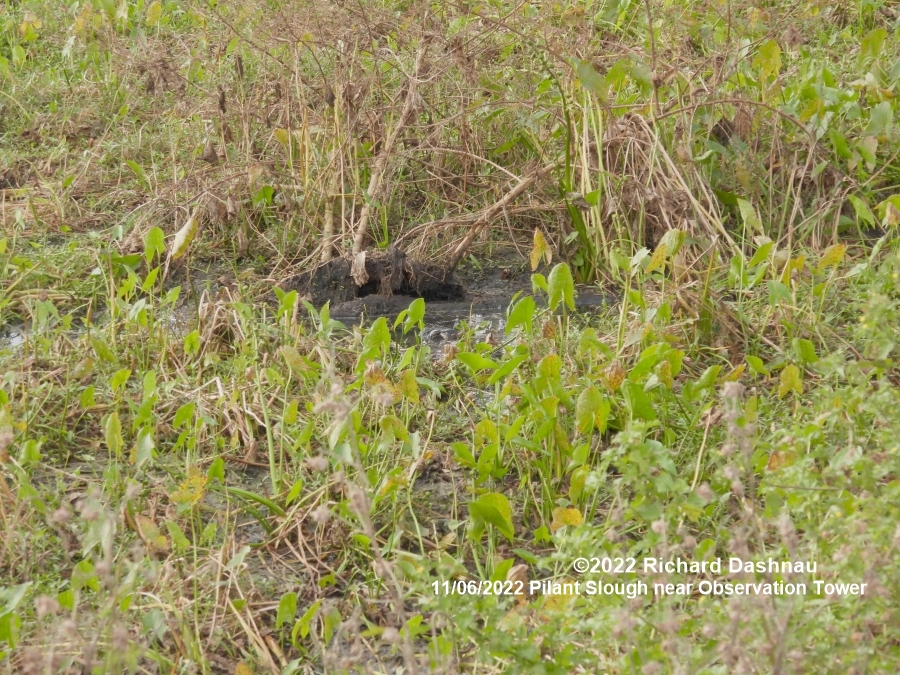
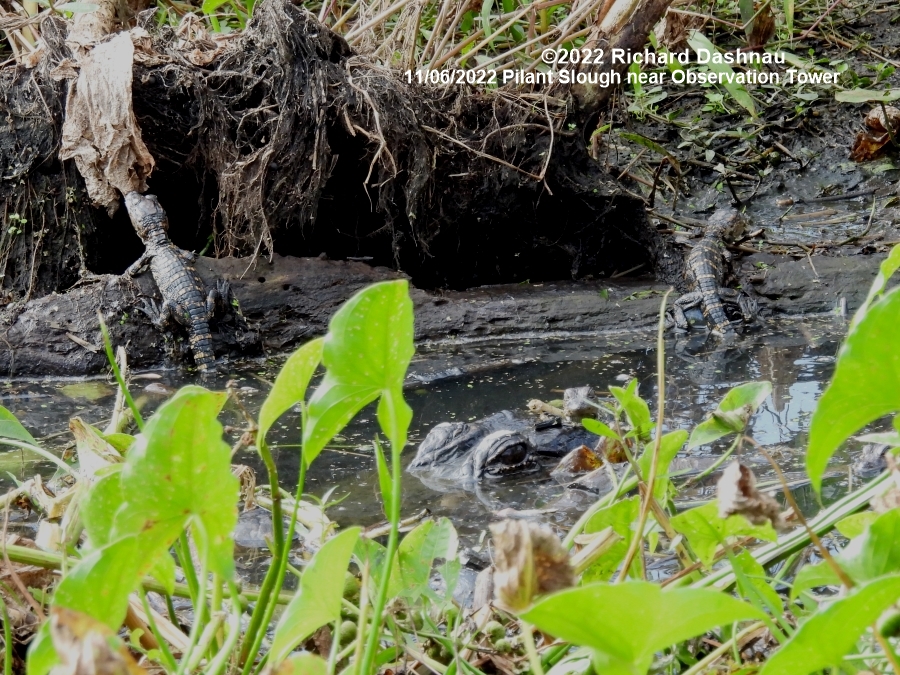
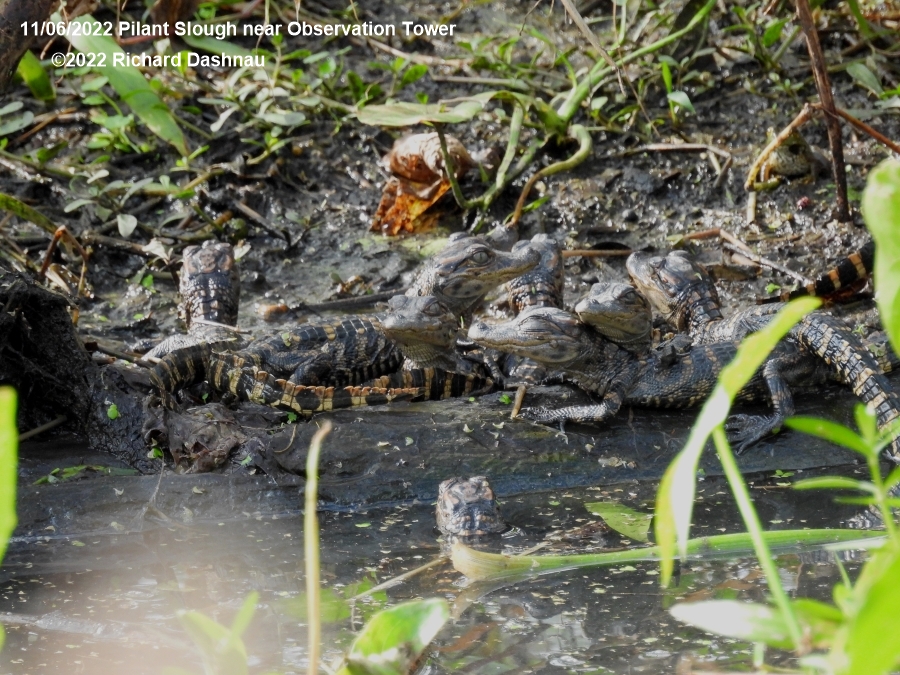
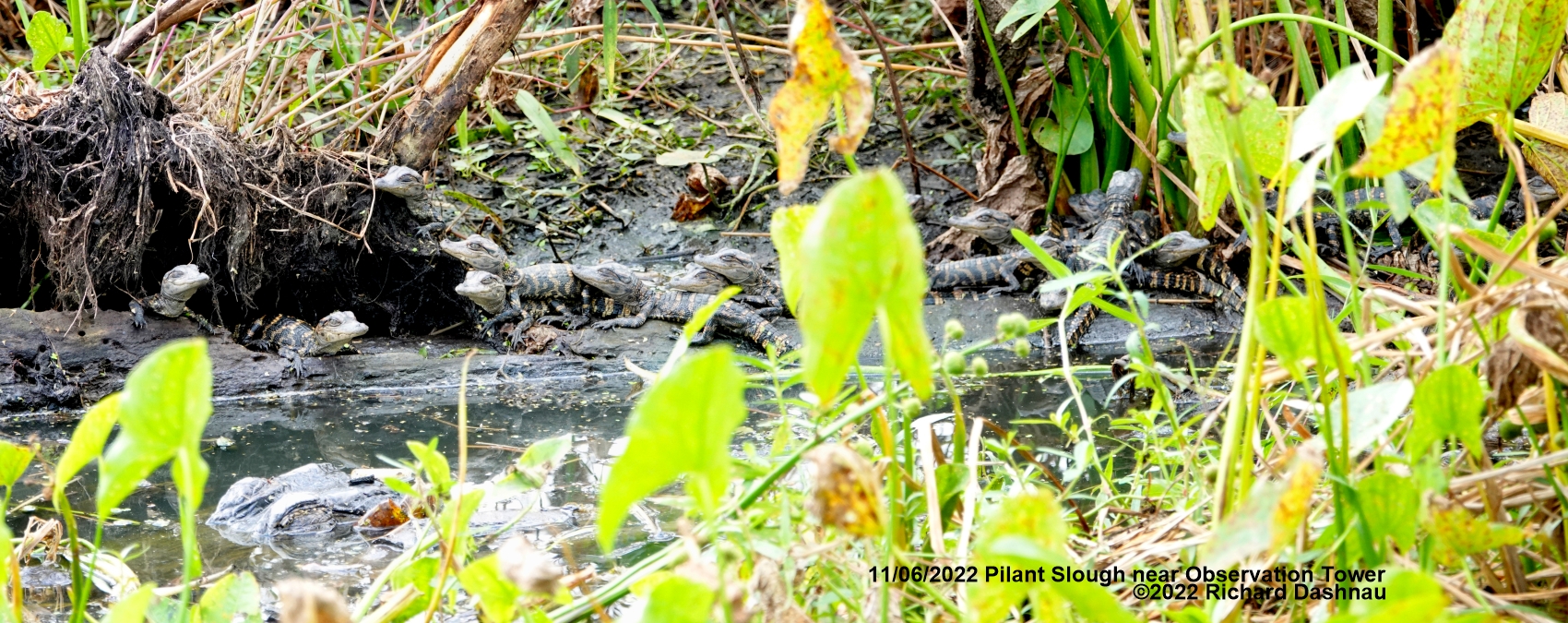
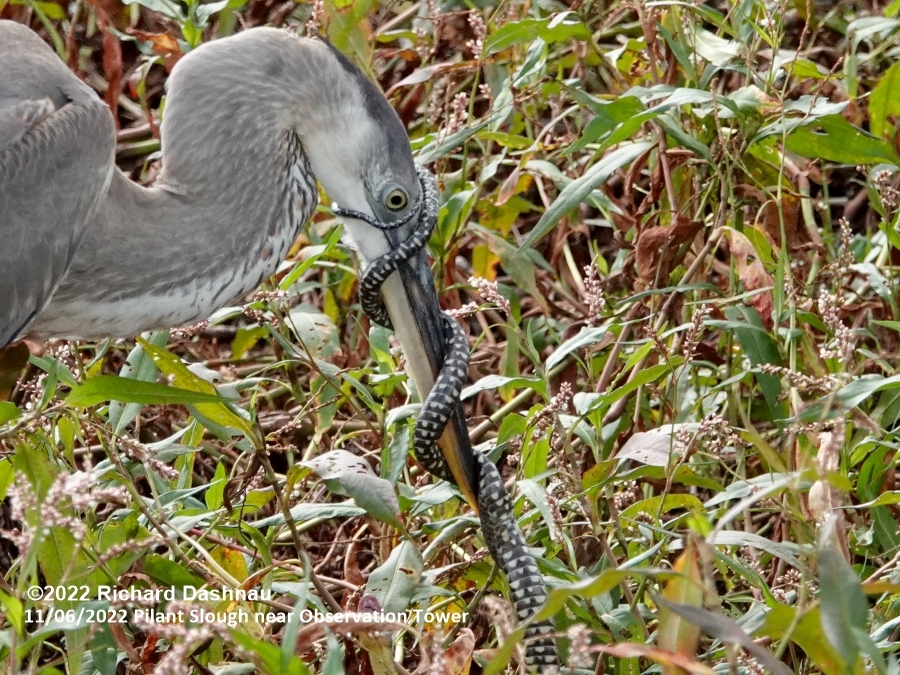
Part 7 of 9: On
11/13/2022
a Great Blue Heron had apparently located the new hiding place
for the
pod. I noticed it walking towards the peeled-back plant.
I
prepared to film if the Heron
approached the pod, but the
mother gator signaled to the Heron with a loud splash. From my
perspective, the Heron hadn't gotten very close, but the
mother seemed
to know it was around.
The splash was not as aggressive as a
headslap; but it did cause the Heron to turn away. However,
the Heron
moved from my side of the spot, and then walked around the
plant and
started
to approach from the other side. It seemed to change its
mind, and turned and walked away. I couldn't capture photos
that show
the relative positions of the pod, mother and Heron. The
image
below is a frame from the short video I got. It shows the
Heron as it
made the second move towards the open spot where the pod was
hidden. (update
12/10/2022)
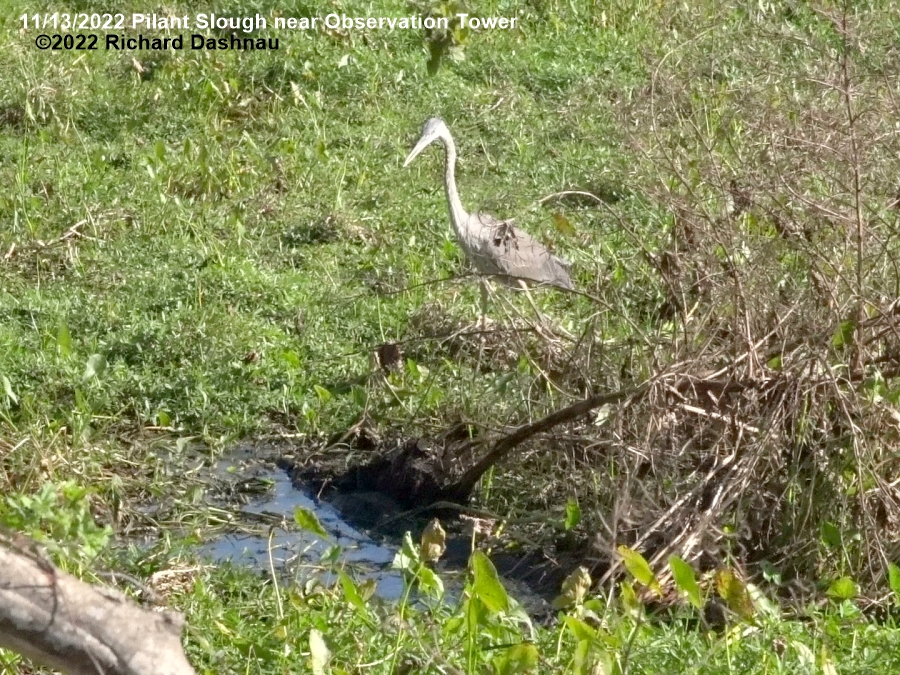
Part 8 of 9: On
11/27/2022
The
park
finally got some rain! . Water levels rose a lot. Although
this
was good news, it also meant that the alligators (and other
animals)
had to readjust to the
water which now covered areas that had been exposed
for the last few months. The two mud banks which had been near
the
culvert were gone. The plants which had been standing and
covered the
area near the pod were gone. The alligators and pod didn't
have
cover, and didn't have a good basking spot. So, the
pod moved to the
bank next to the trail, and the mother came to bask on the
trail. A little
while after the mom gator
first got on the trail, another large alligator climbed out of
Pilant
Slough a
few yards West, and crossed the trail into Pilant Lake.
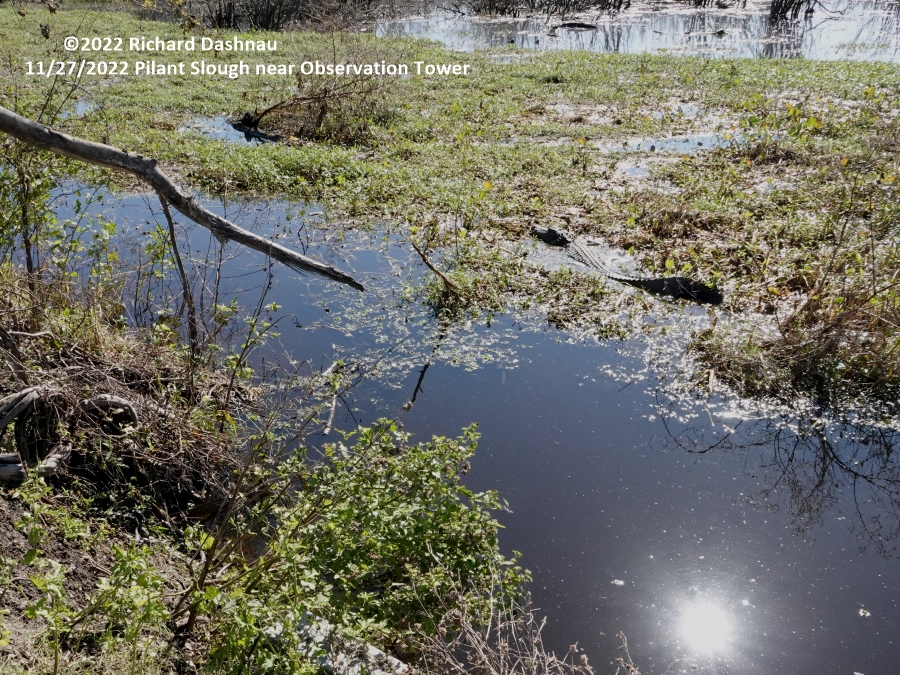
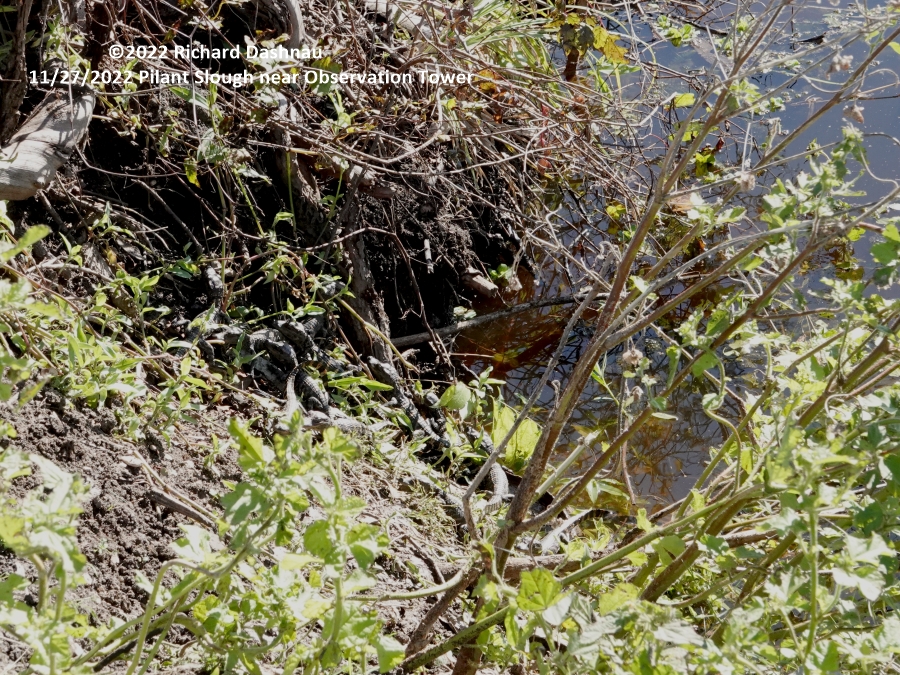
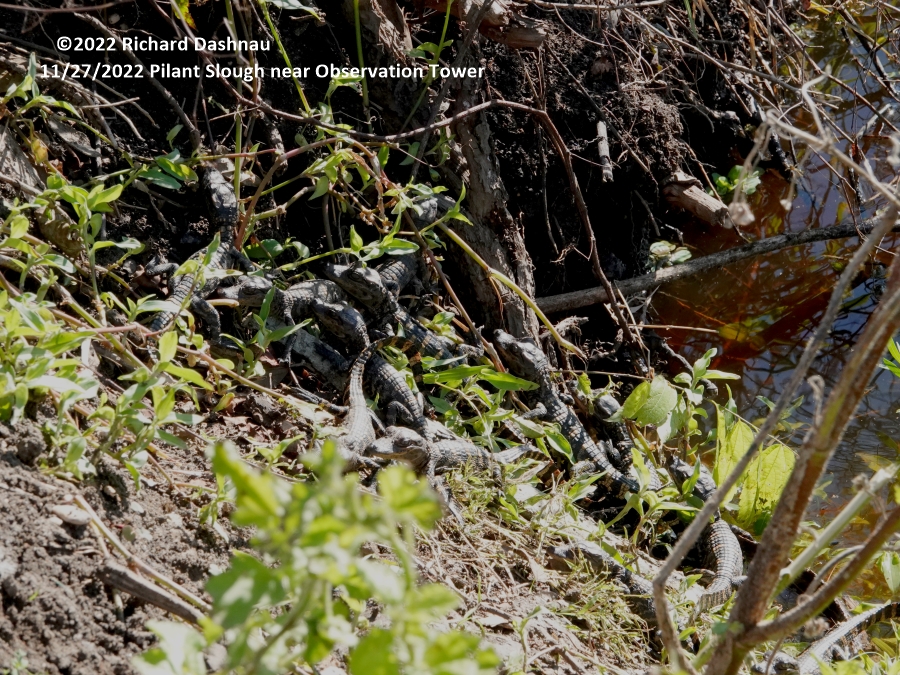
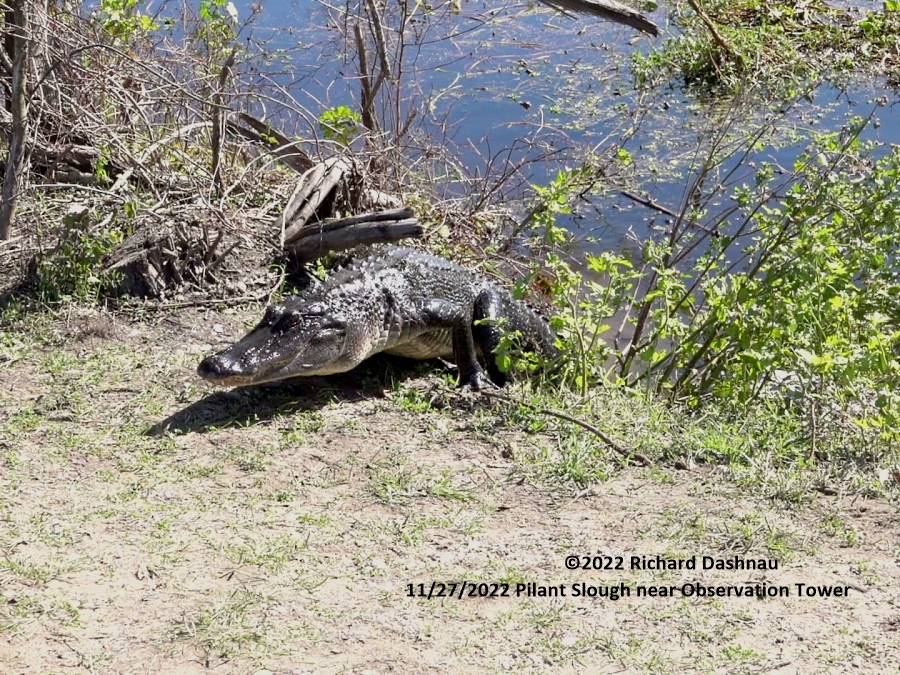
Compare
the images from this day to the previous days. There is a big
difference in plant cover. The baby gators gathered on the
bank near the left end of
the concrete, below where the mom
gator was resting. A Great
Blue Heron moved in, stalking on the mat of plants (2nd image
below).
While this was happening, I was on the trail along with
a number
of park visitors. I got ready
with the camera, expecting to see some
kind of drama unfold. The heron took a few more steps closer
to the
near edge of the mat--when mom gator launched herself
off the
concrete and into
the water! This was done without any
warning. She was lying still--and then she was airborne. I
started
filming the heron because I expected her to surface near it.
But, she
didn't go that way.
She surfaced nearer the babies. The heron just
turned walked away...but not too far (3rd image below shows
ripples
from mom's dive, and the heron turned away).
The heron
didn't go very far, and the mom gator came back up onto
the
trail. The heron continued its slow prospecting steps, while
the mother
came back onto the trail. I did not take a
picture of her then.
She was not facing the water when she relaxed. Things were
quiet for
about 20 minutes. Then the heron moved to the edge of the mat
near us.
It stabbed down and
caught something. Whatever it was, it
was very small (less than 1/2 inch, because I could barely see
anything
there). But the heron picked it up, tossed it, and
squeezed it.
There was a very
small "crunch" sound. Mom gator raised her head,
turned towards the water, saw the heron (I think), and
launched into
the water again-all in one burst of movement. All I could do
was shoot
video
of the aftermath-so I focused on the heron again. The 4th
picture below
shows the ripples from mom gator's second dive. She surfaced
near the
babies again. Here were 2 great
demonstrations of her guarding the babies.
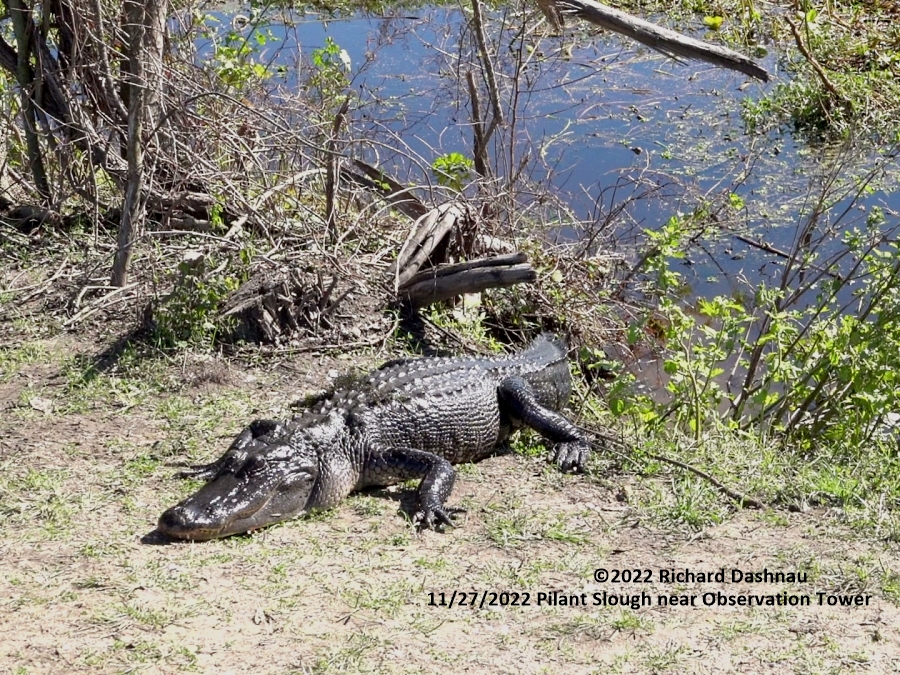
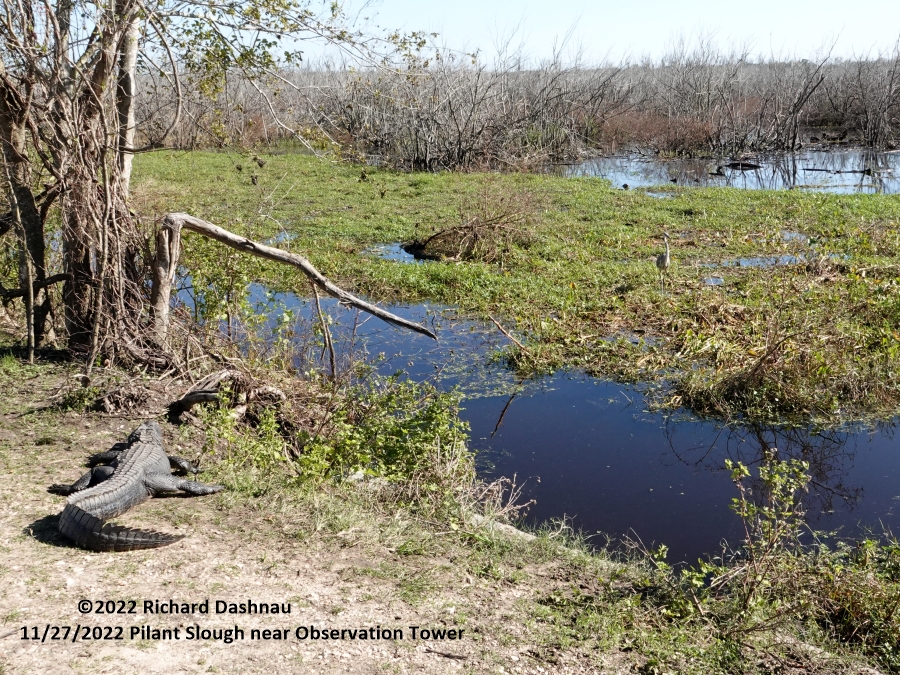
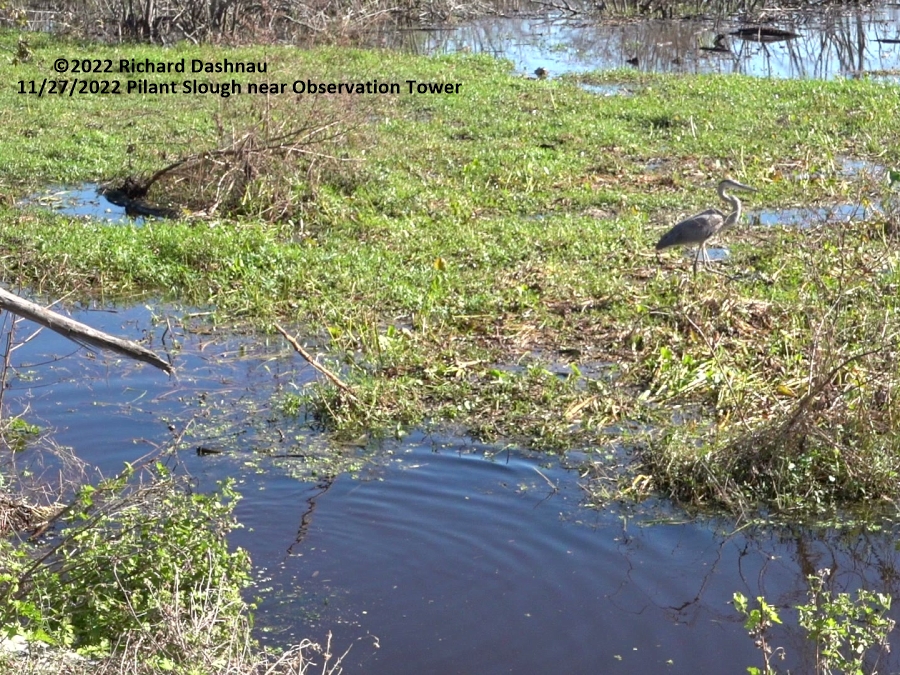
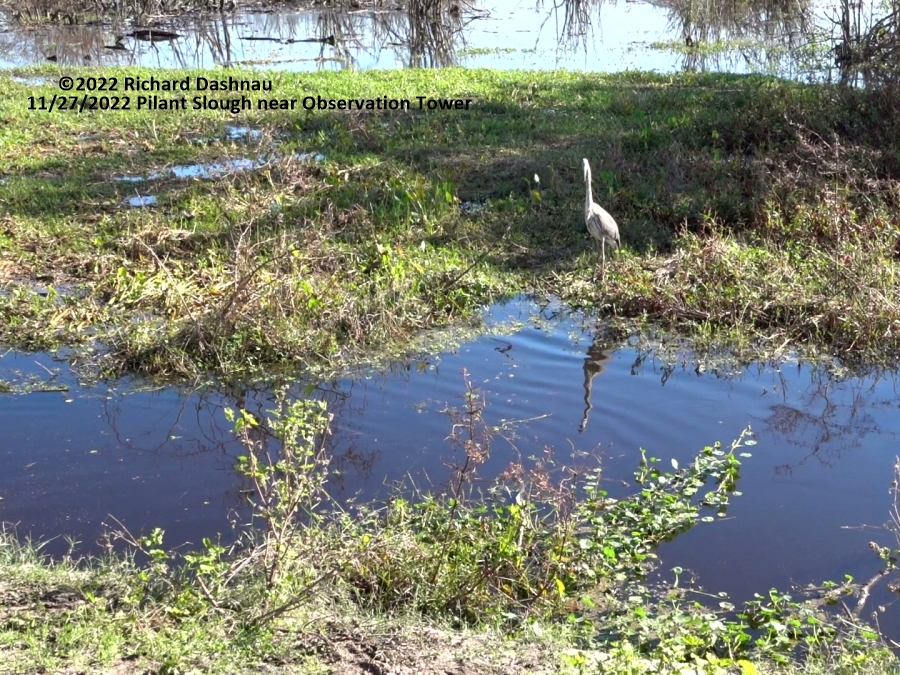
The
first two pictures below show the mother's head where she
surfaced. The
babies had been near that left end of the concrete. They were
hiding by
then. The heron finally left, and the mom
gator came back onto the trail to rest.
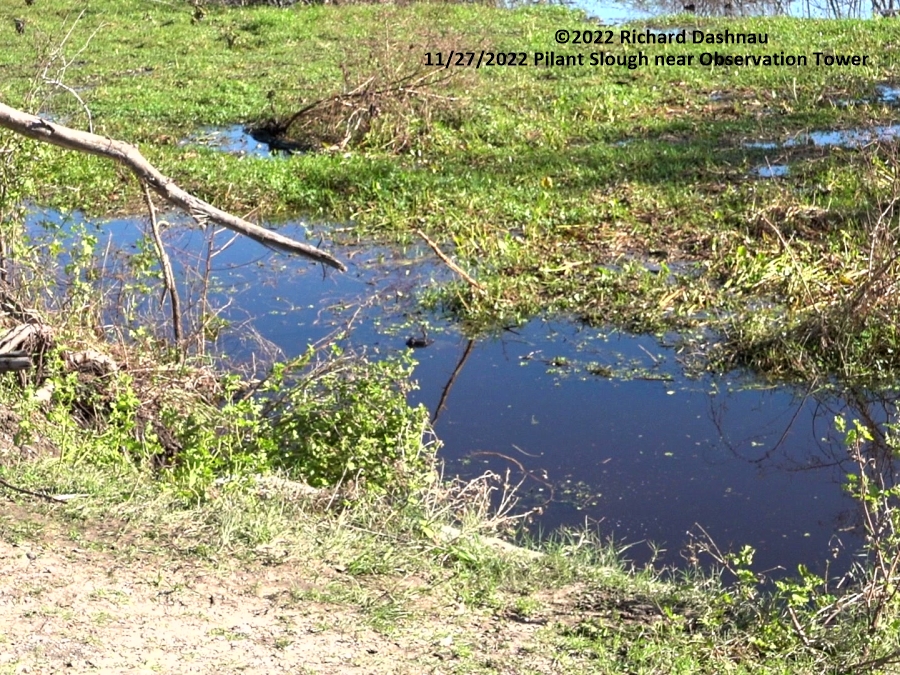
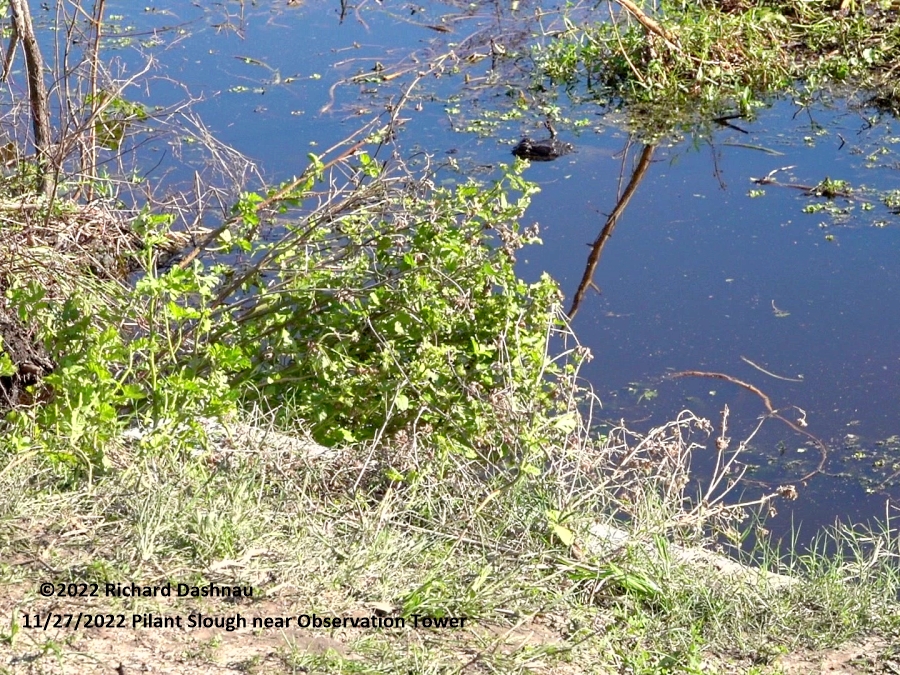
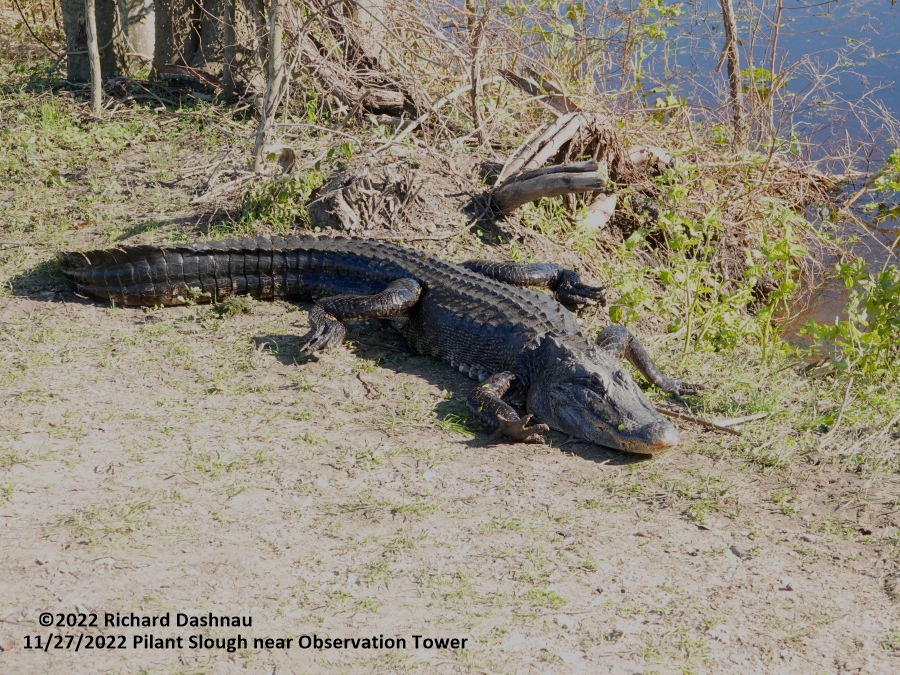
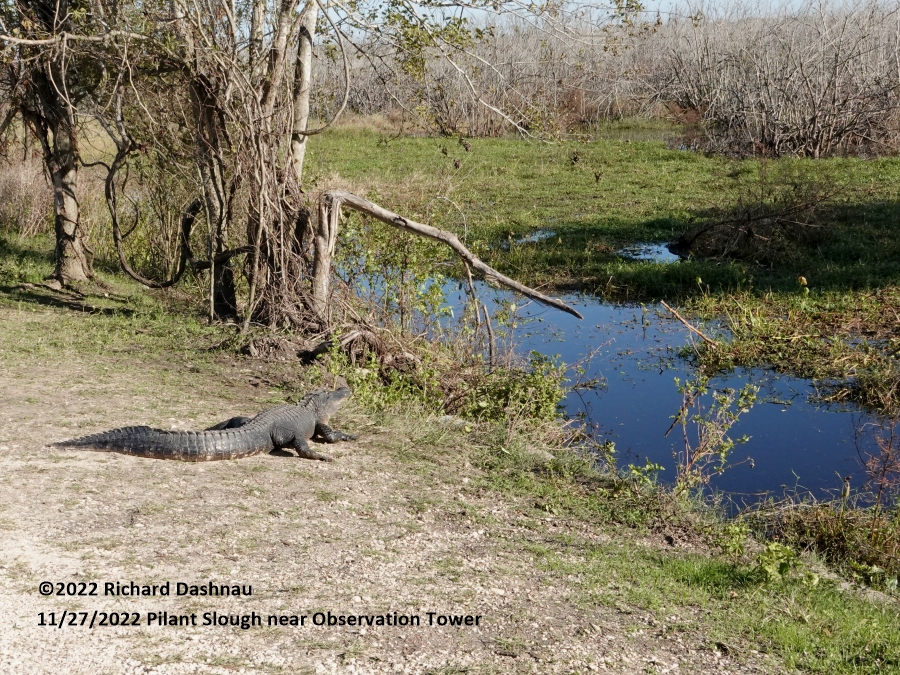
Part 9 of 9: On
12/04/2022
The
water
was still high. In the morning, the mother alligator was
visible,
but I couldn't see any of the babies at first.
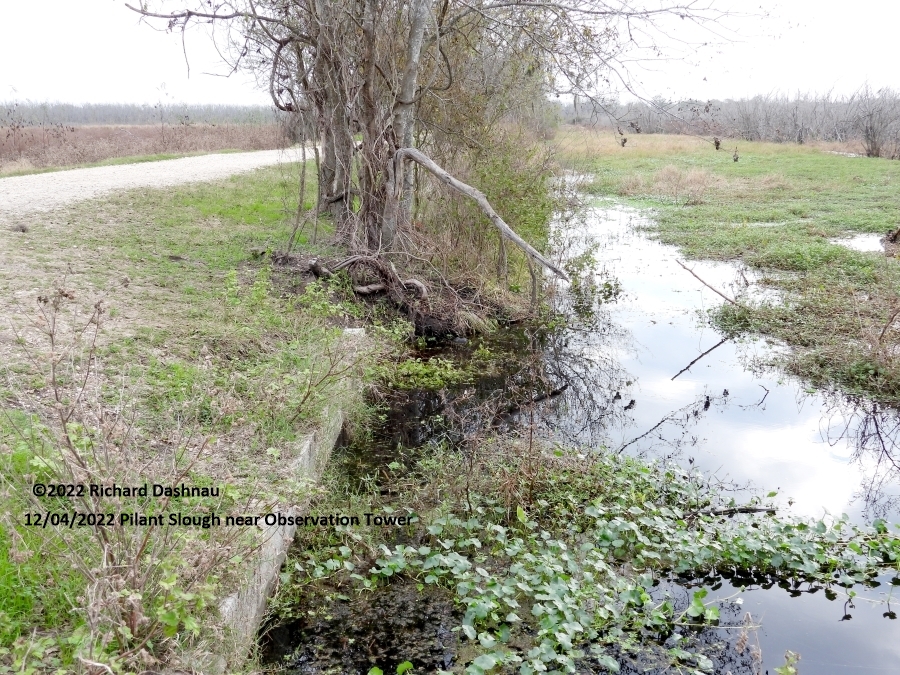
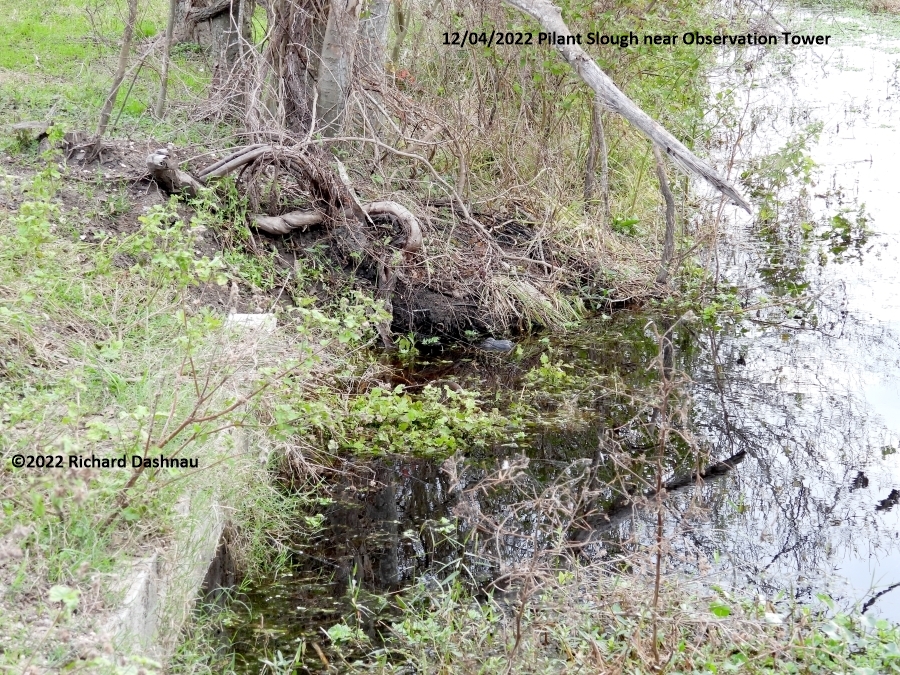
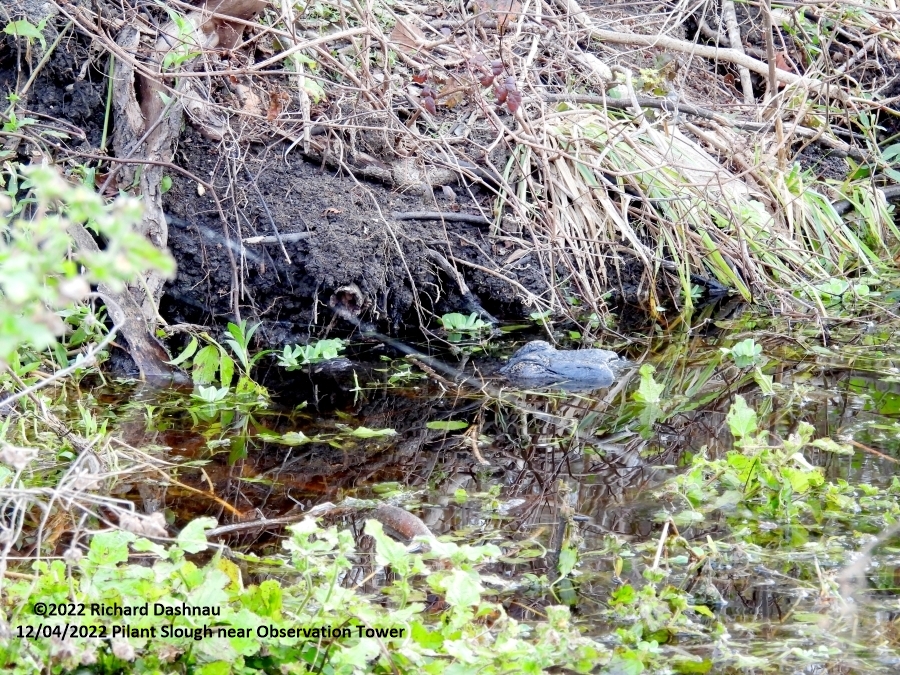
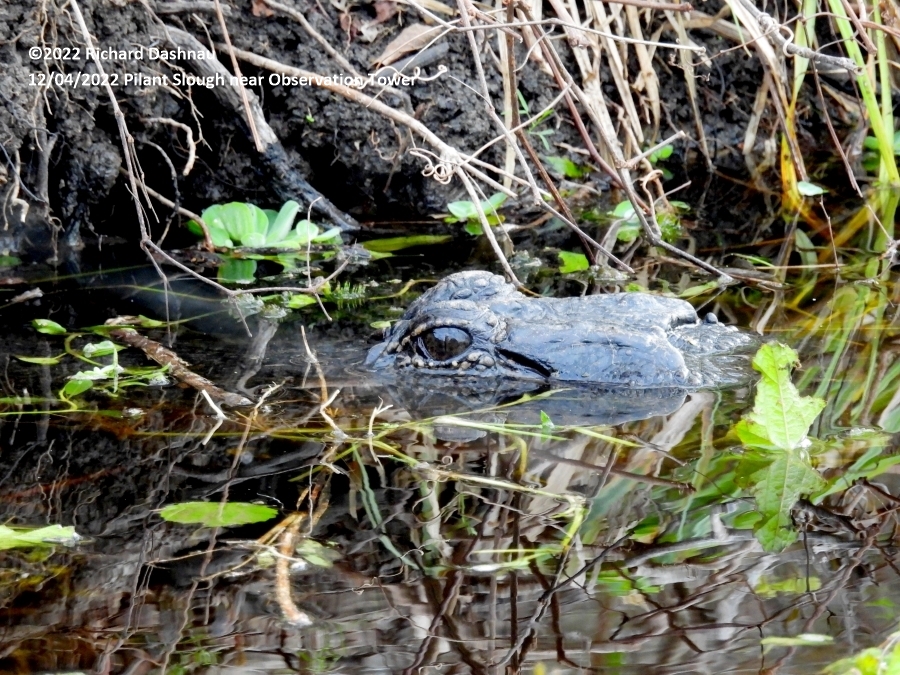
A larger
alligator (probably the "2nd gator" that had been sharing the
area
all along) moved in behind the mother! At one point, it even
bumped the mother alligator and one of them made a
very low, quiet, short "growl". The mother didn't move,
and the
other alligator backed off and moved away. It eventually
climbed onto the floating plant mat. One
picture shows how close
the
2nd gator was, and also shows the size difference between
them.
Babies started to appear after a couple hours. They seemed to
be coming
out of a cavity under the bank, near mom gator's
nose in the last picture.
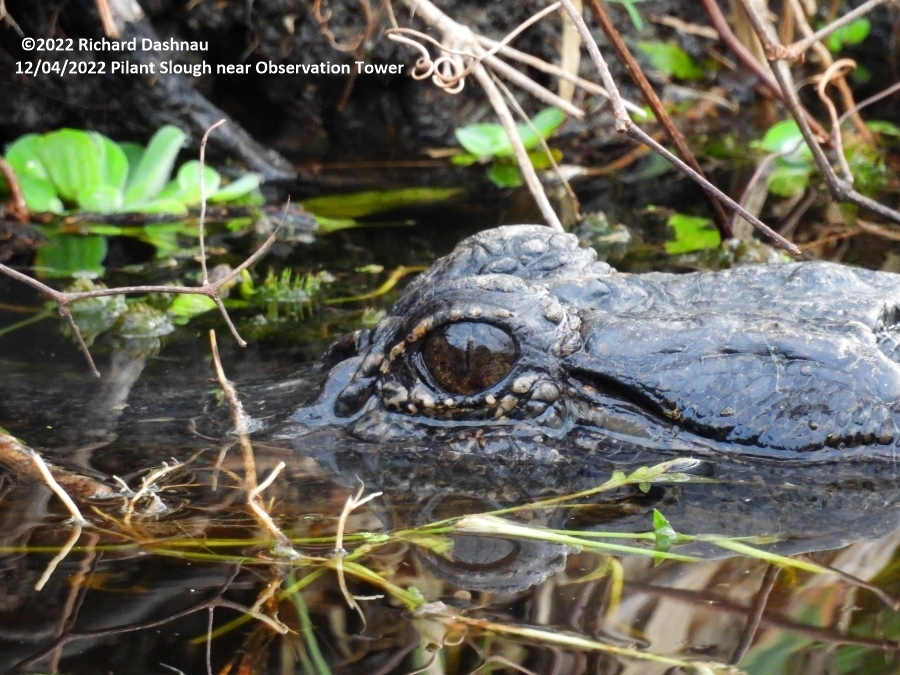
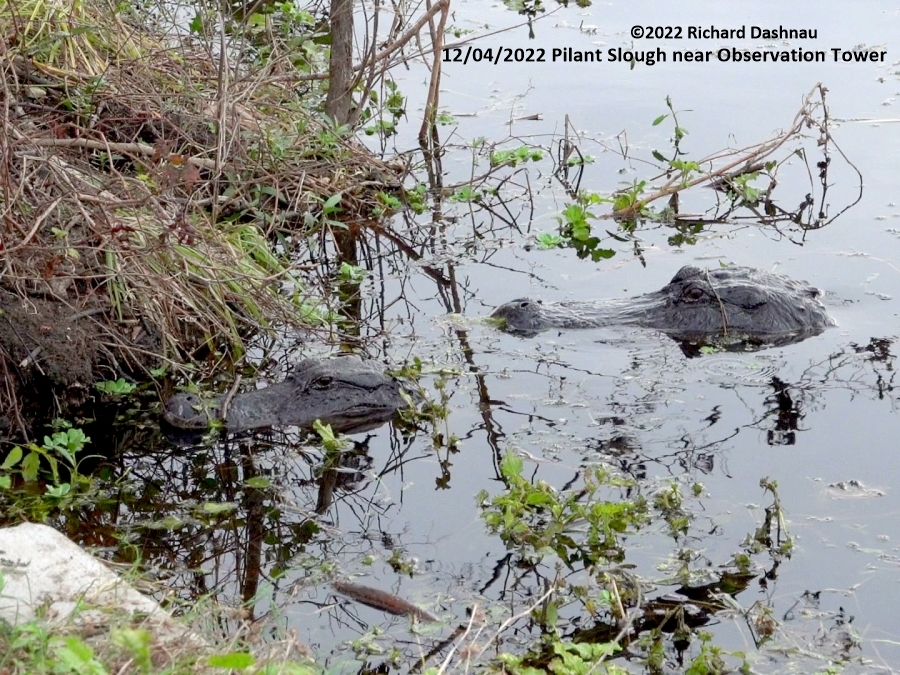
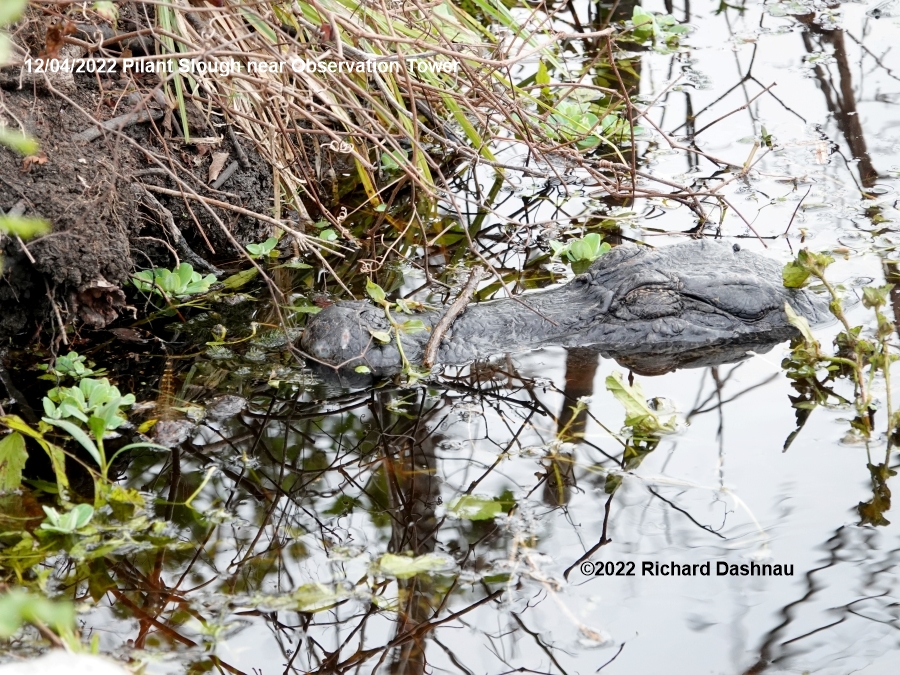
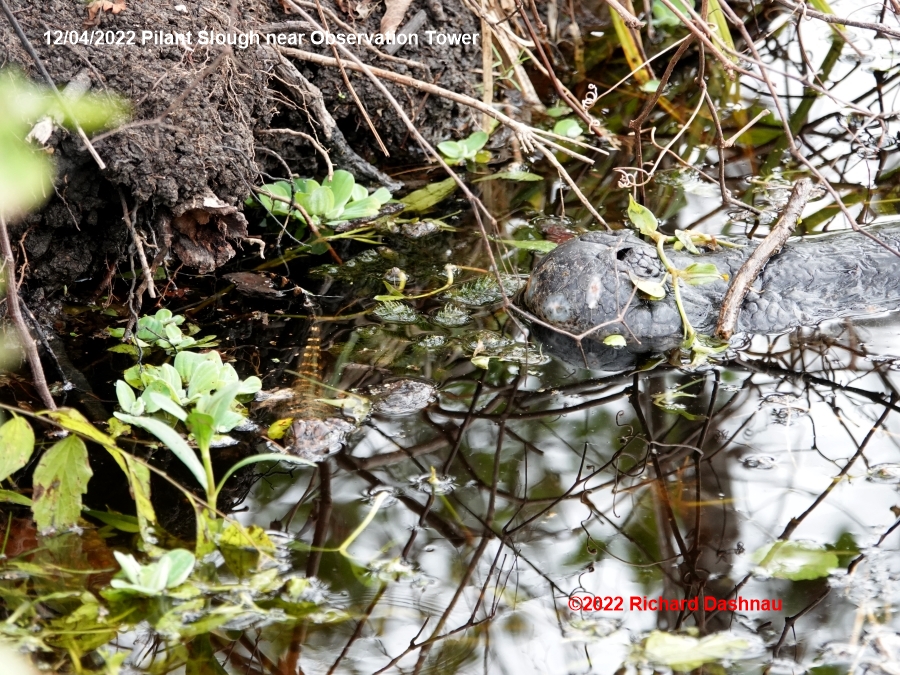
The
mother also moved over to the plant mat (she's at the center
in the 2nd
image below). More babies moved out of that hidden cavity and
climbed
onto the bank. They were a few feet below
the trail, well
camouflaged, and near the water. Their mother was within sight
of the
pod. It was a situation that I've seen many times over the
years.
During all of those times, I've enjoyed
watching the baby
alligators, and enjoying the quiet times with park visitors
that came
by--for hours on some days. But today was going to be
different.
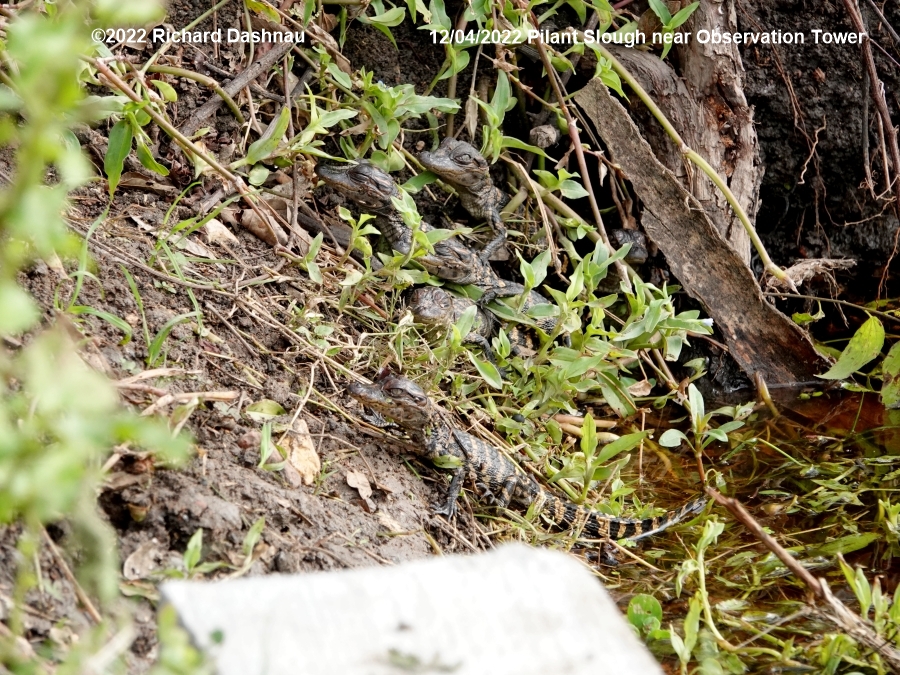
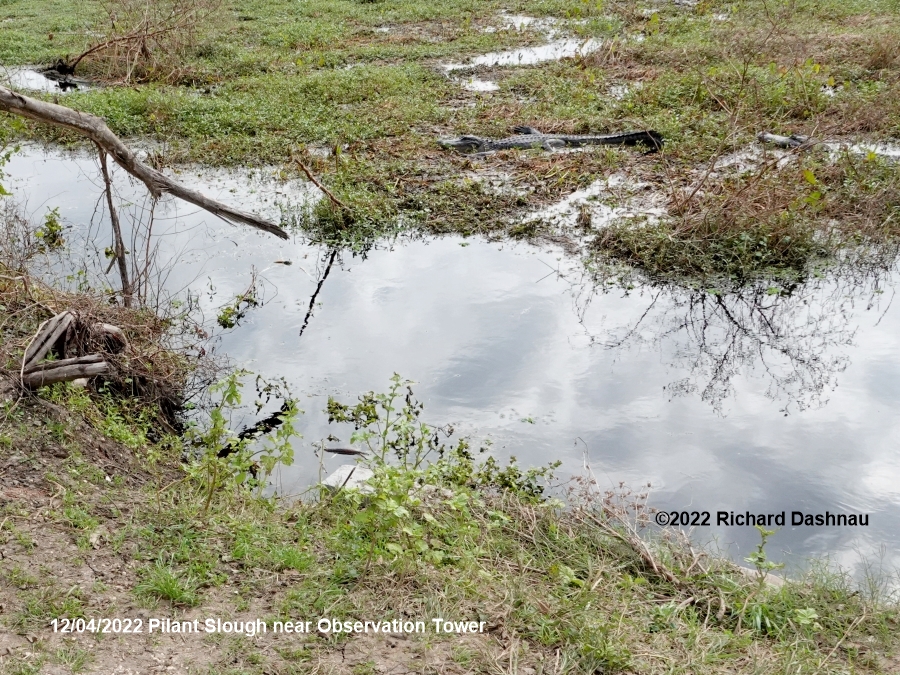
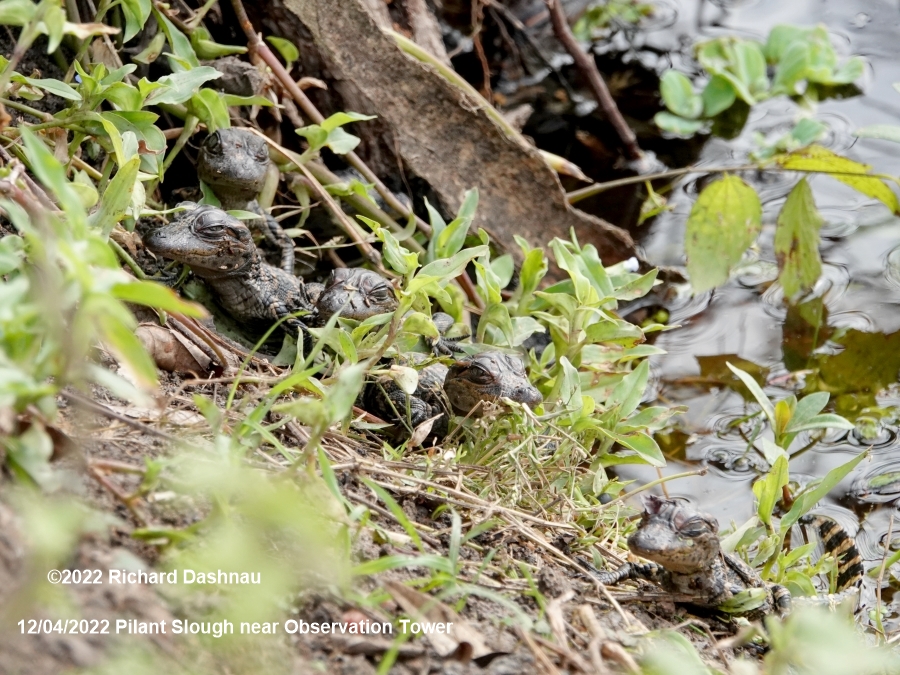
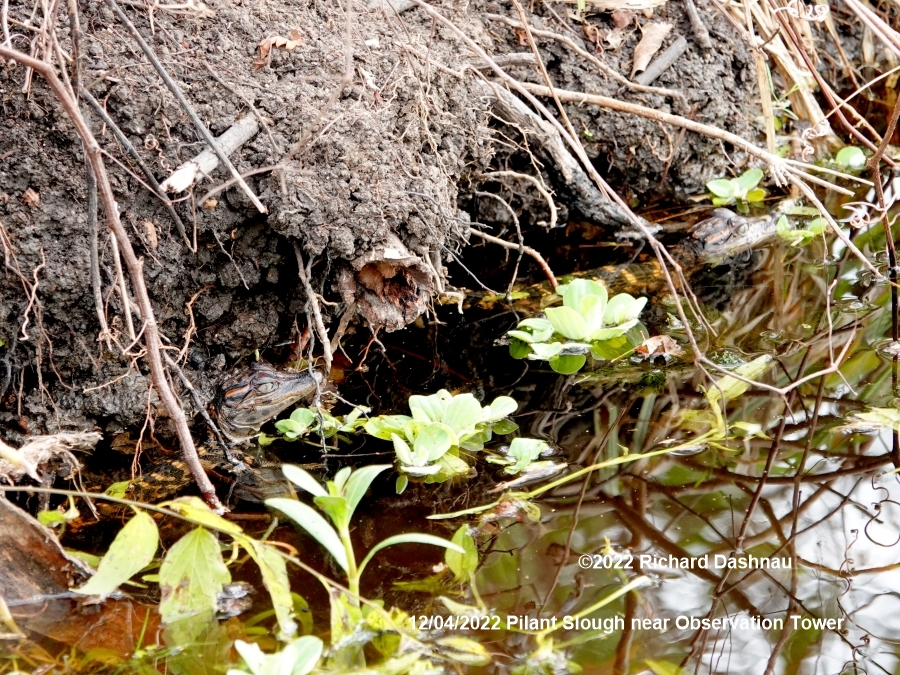
At
about 12:30, I was doing the usual "crowd control"-keeping
people back
from the bank so they wouldn't scare the babies; talking about
the
adult gators, etc. There was a small group of
visitors around me. As
we talked, and pointed, a Great Blue Heron walked along the
bank,
coming from the short wooden bridge. It came closer to us,
then walked
at the edge of the trail
--only 6
feet away from us!!--then
moved to the edge of the concrete culvert. I asked
everyone to be
still, and watch what would happen next. The heron paced to
the left edge
of the culvert,
looked down the bank, stalked down the bank, and grabbed a
baby alligator! Right
in front of us!
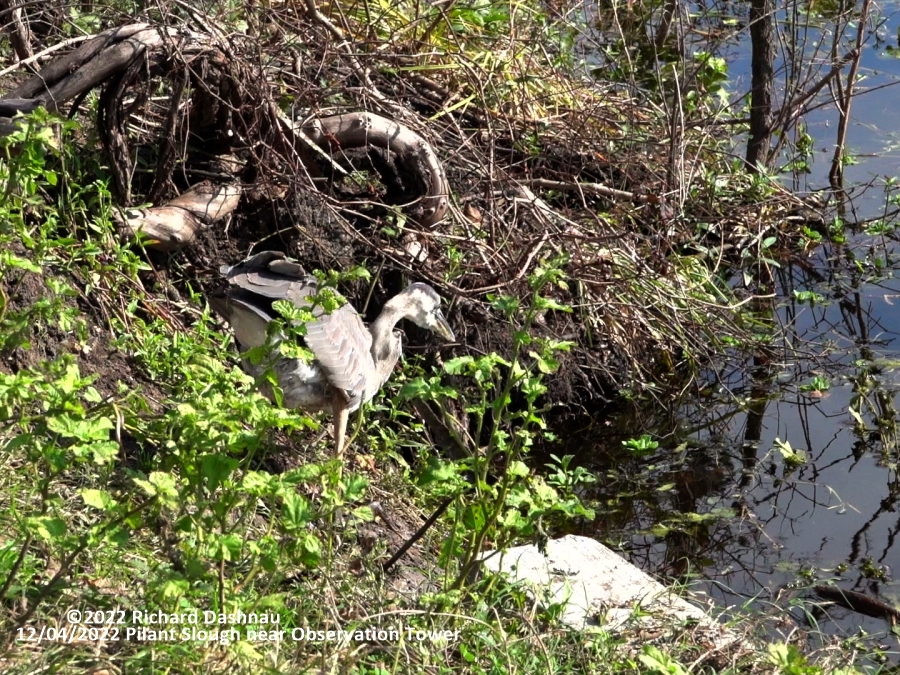
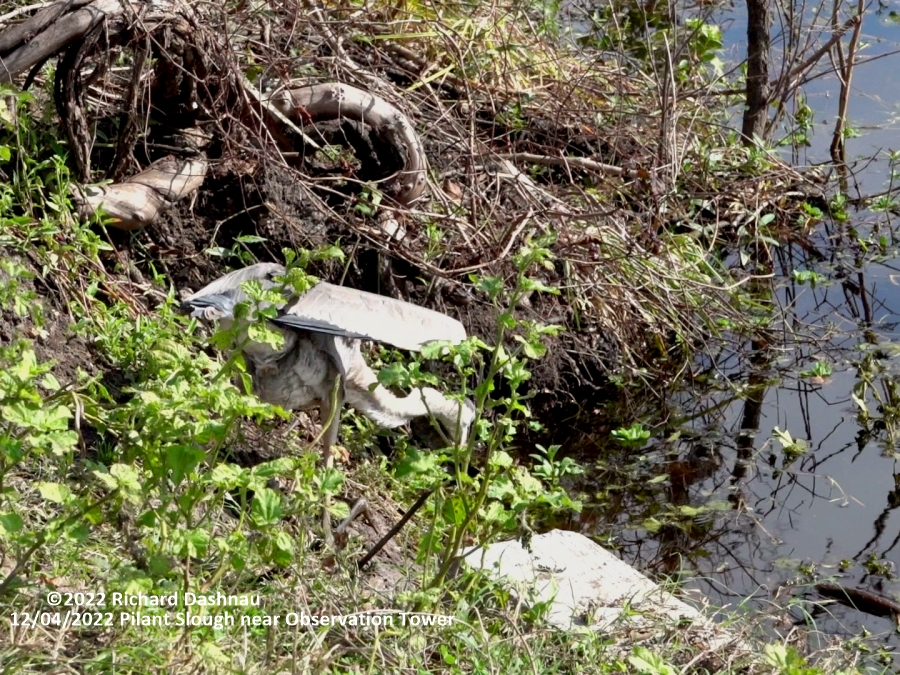
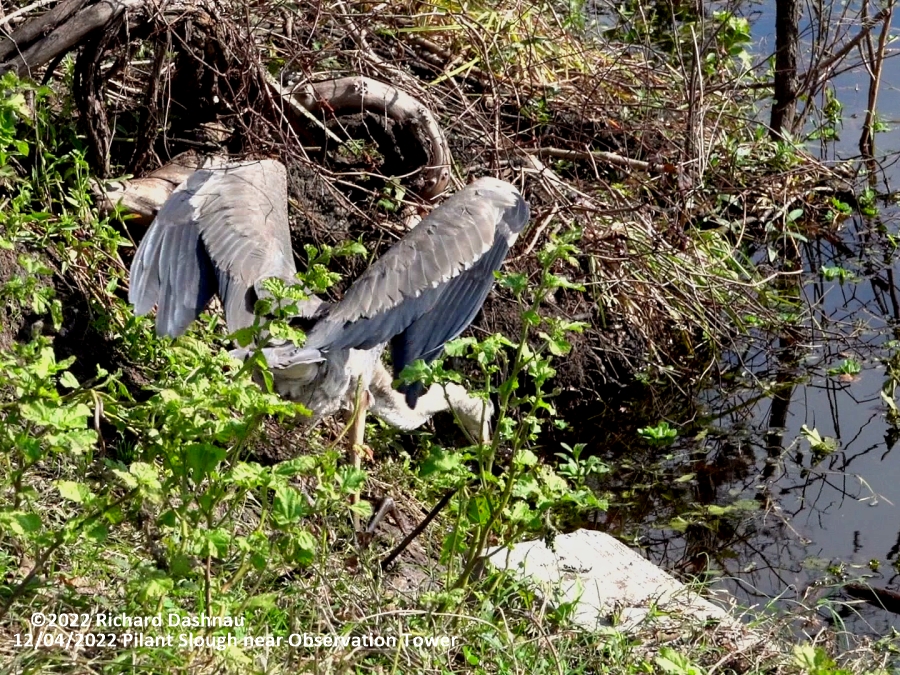
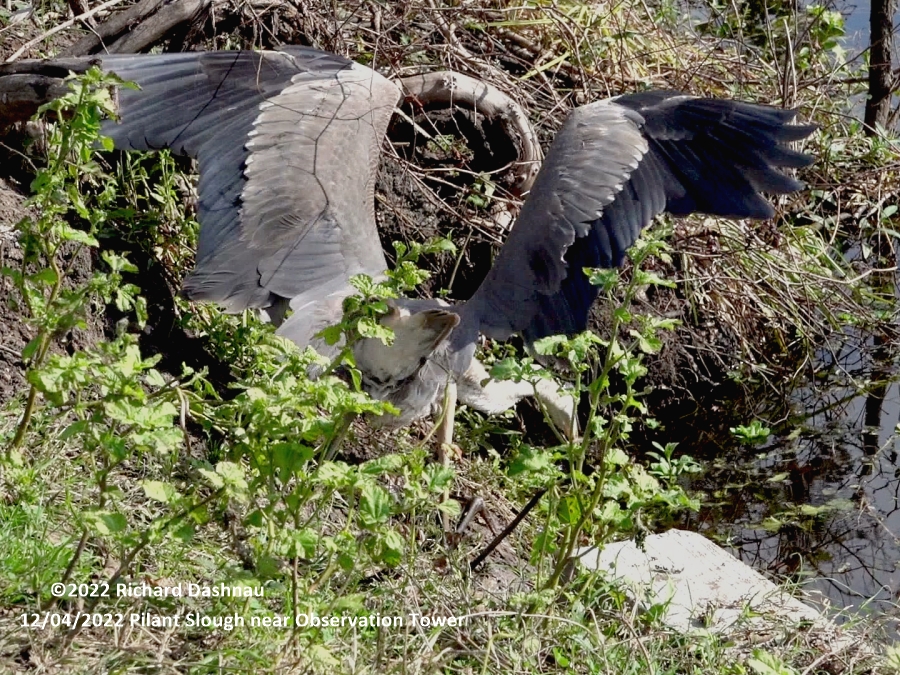
The
images of the heron here are frames from video. Standing
just 6
feet from the heron, I had a brief, amazed look of those
huge
wings opened in front of me. Reviewing the images later, I
can
admire the balance and physical prowess being demonstrated.
The open
wings provide balance and stability to offset the weight of
the heron's
neck, the energy of its strike and
recovery; all as it was leaning
forward and down while standing on a steep bank. Imagine
standing in
the same spot, and reaching down to grab something with your
hand
without falling into
the water, and you may have some idea of why I could admire
what was happened here. The heron
turned, walked up the bank, took a step or two and took off
with the baby.
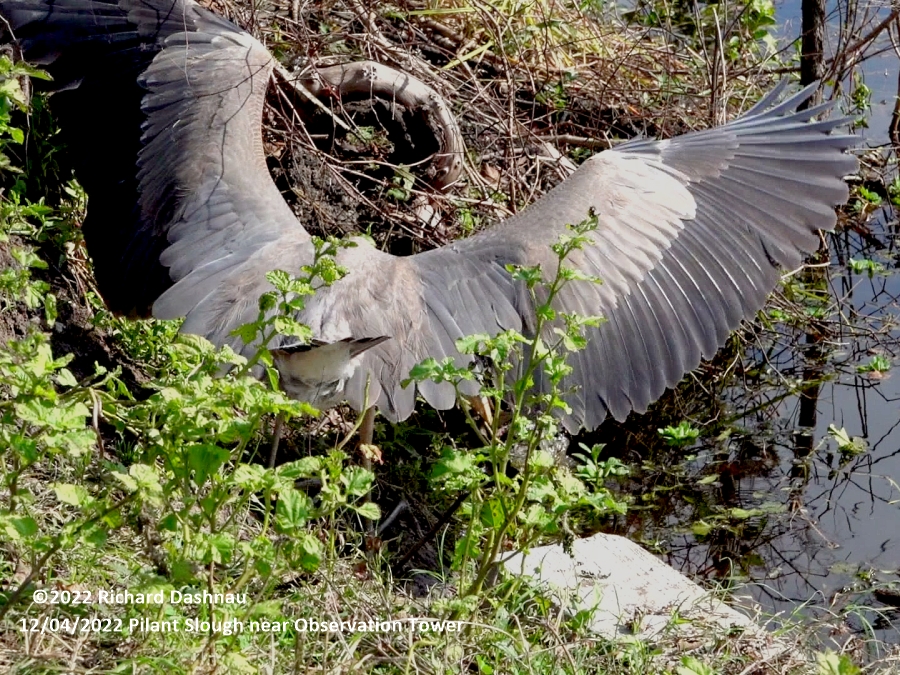
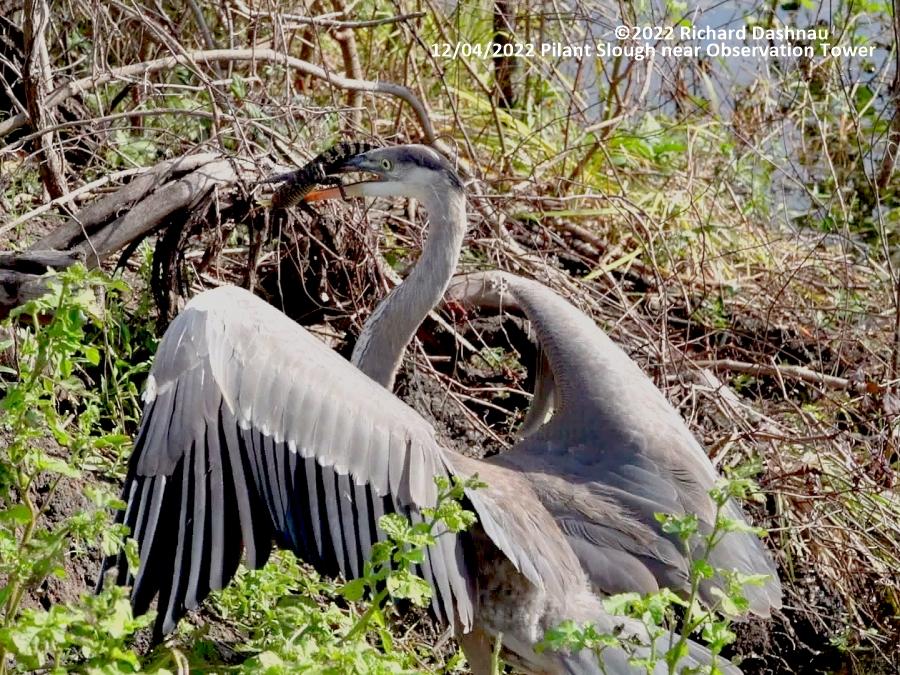
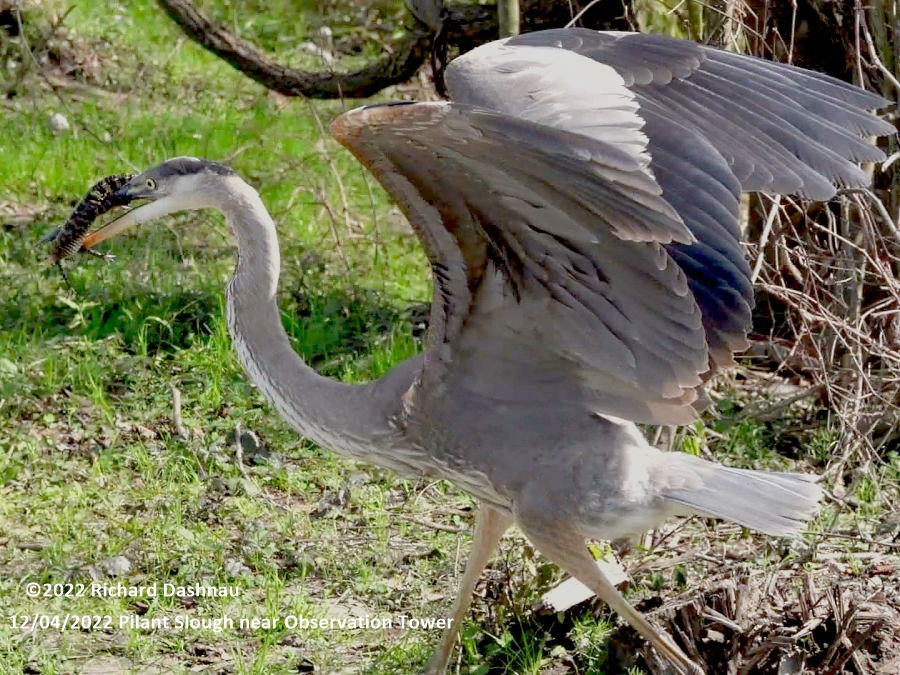
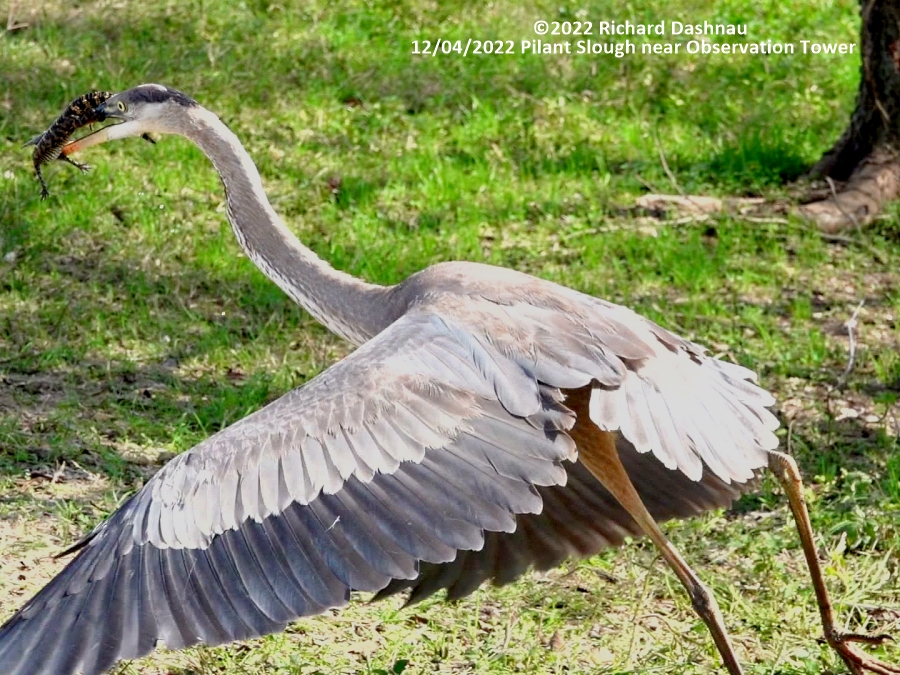
It
landed about 50 yards West, on the plant mats in Pilant
Slough, and we
could see it finish eating the hatchling.The mother responded
by rushing into
the water and over to the bank, but she
hadn't begun moving
until after the heron had gotten back onto the trail, far too
late to save the heron's prey. The babies had
all submerged.
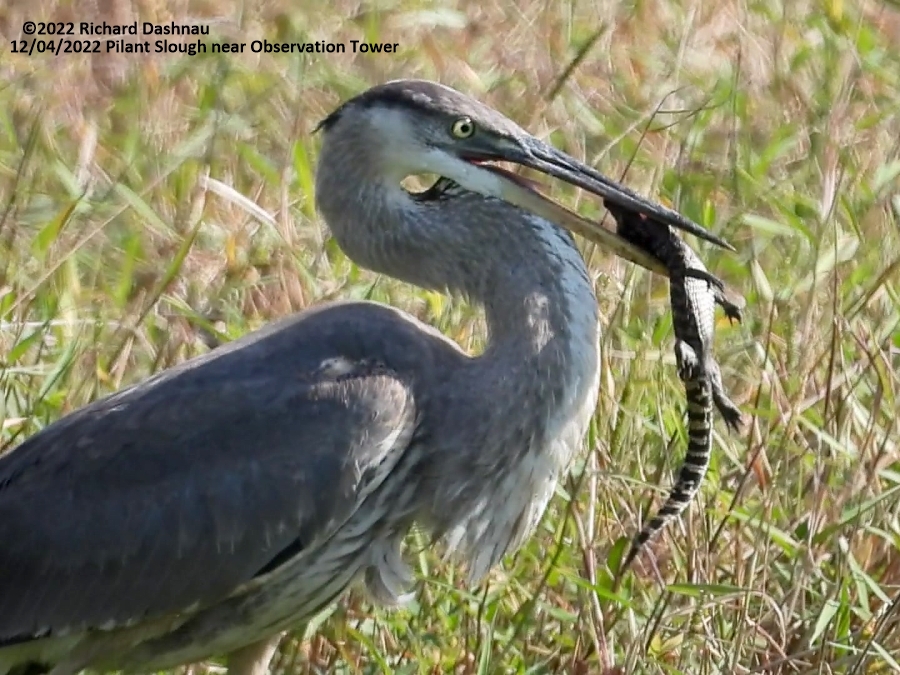
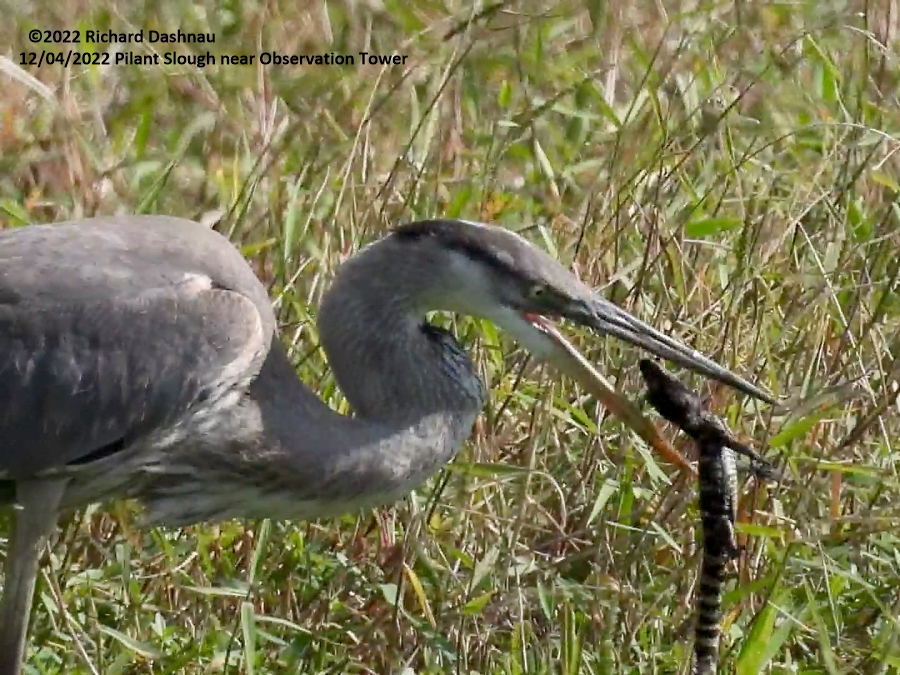
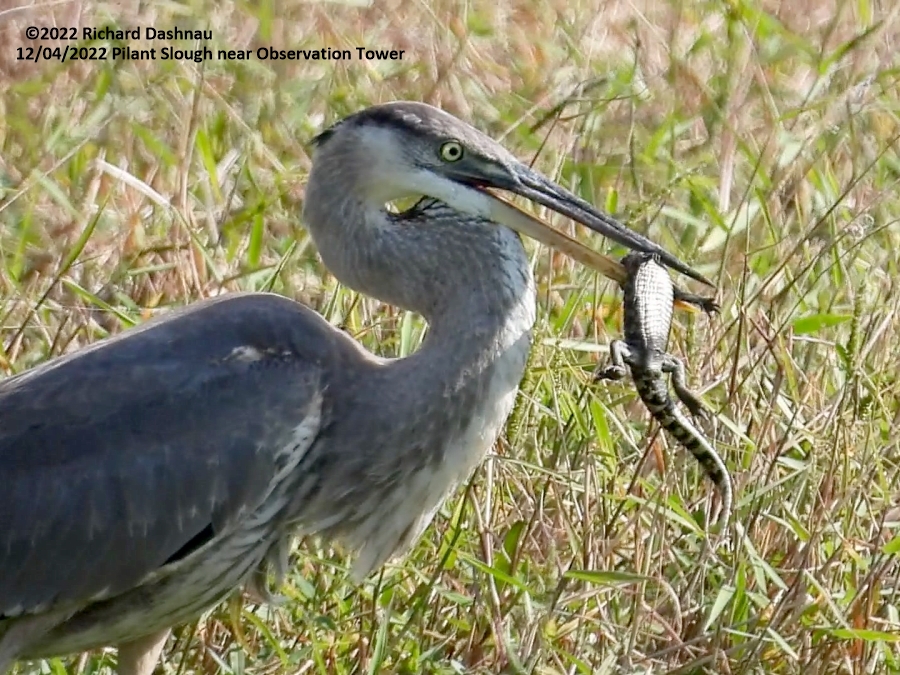
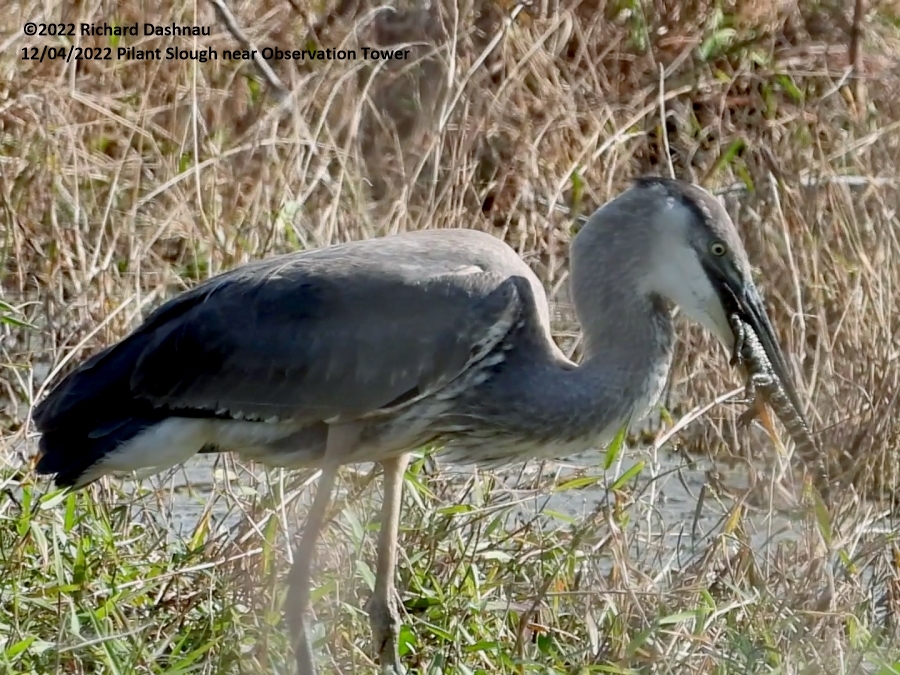
The mother
climbed onto the trail near the culvert, and rested
there. She was still there when I left. Although I
knew the heron was stalking the babies, I was still very
surprised that it ignored
me and the crowd and grabbed one. As mentioned
above,
I've put together an 11-minute long video that summarizes this,
with
the added attraction of video clips showing some of the action.
That
11-minute video is here.
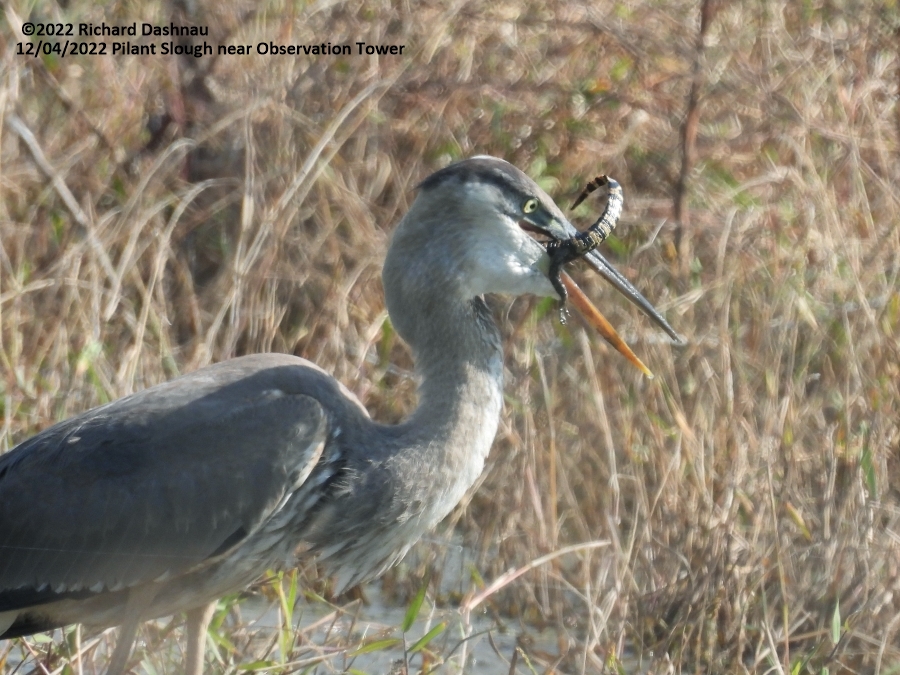
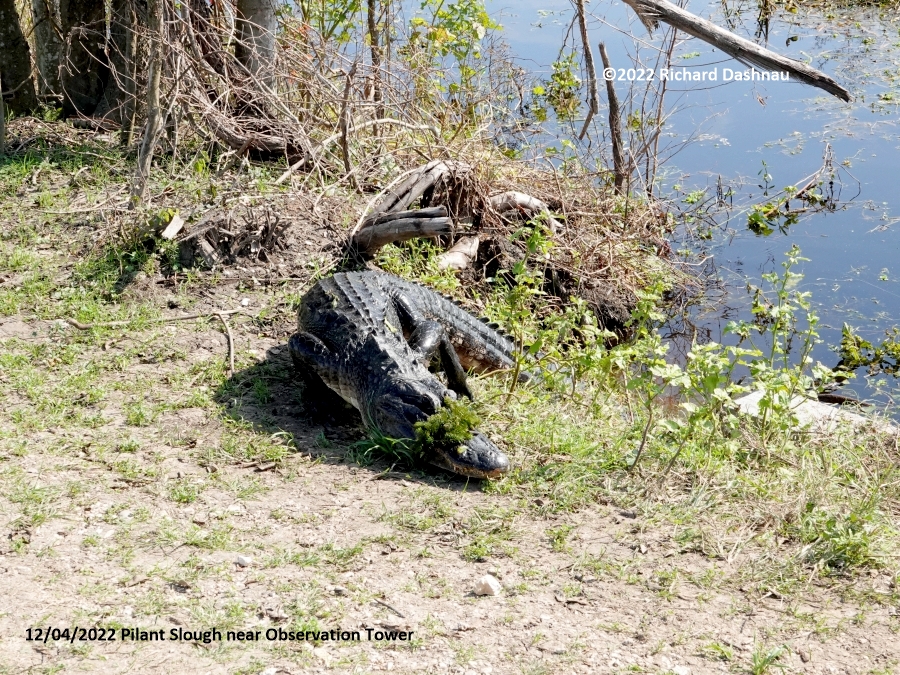
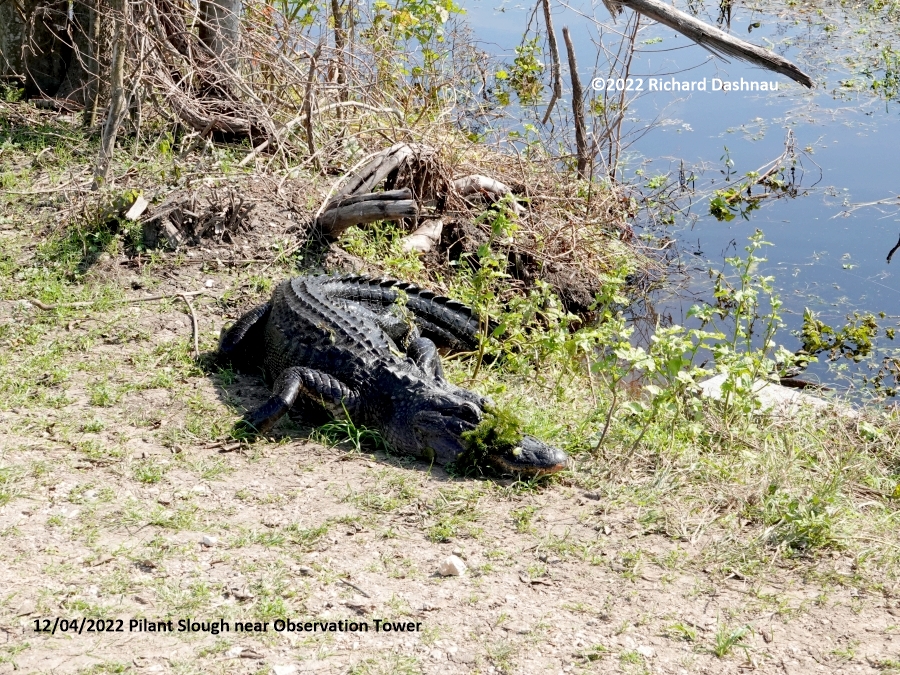
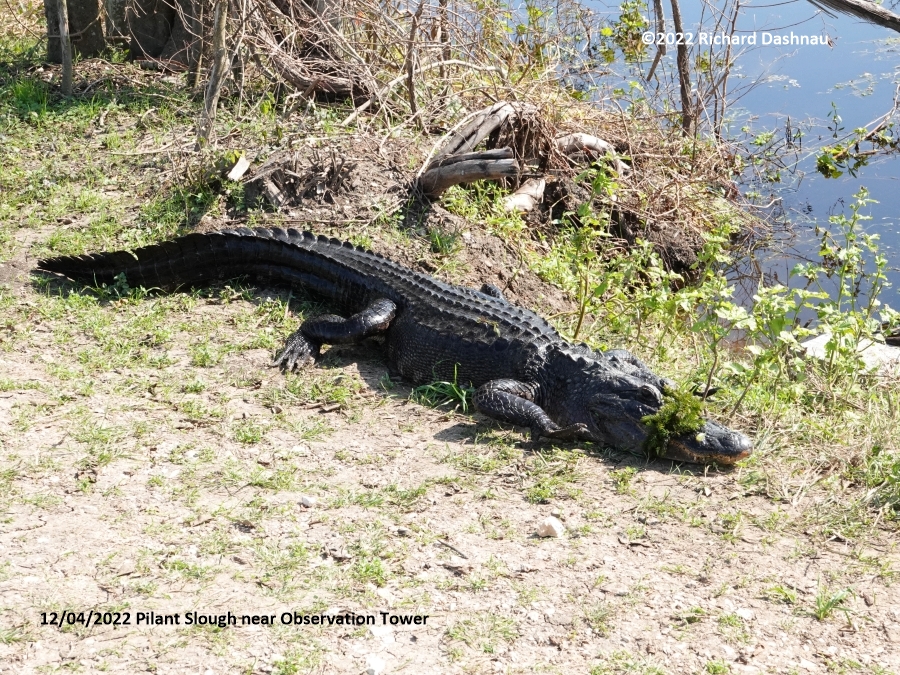
It
took me many hours to compile the above events into this
summary. But,
I was inspired by what happened on 12/4/2022. After years of
observing the herons and alligators sharing the
environment
in the park, I was finally able to witness a string of events
that-together-answered a question for me. It appears that the
herons
(and possibly other birds) knew that baby alligators
were in the
area. Although the herons performed their usual prospecting
behavior in
the area, they seemed to pay special attention the vicinity near
the
baby alligators. It's probable that once
a heron (or herons) learned
of the pod, that they'd return to that spot. But the pod
did
move, and a heron had to find it. Aside from seeing the
babies
(which is hard to do) what else would
alert herons to the presence of a pod of babies?
Well...how do we
sometimes locate a pod? We listen for chirps from the
babies.
Babies in a pod chirp intermittently, for various reasons.
As
they forage, if they move into the water, or out of the water,
if the
mother moves--any of these situations (and more) can cause a few
chirps
here and there. This is not the same as the
chorus of chirps that
can happen if something scares the babies. I suspect that an
expert
hunter-such as a Great Blue Heron-would immediately recognize
those
chirps and, from some
distance away, it would begin searching for
a pod. Now, it seems obvious, although I haven't researched to
see if
this has been described anywhere "in the literature". I'd
never
considered
this in all the years I've been watching them. Now that I
see that Great Blue Herons possibly listen for baby alligators,
I
wonder if Great Blue Herons also use hearing to find Lesser
Sirens.
Sirens are also known to vocalize. I've seen many examples of
Herons catching sirens, and have wondered how the herons find
them.
I've examples of that on my Great Blue Heron page.
Sirens
are generally nocturnal, and stay hidden and submerged during
the day,
so there must be very little that can be seen from above.
Part
10: On
12/25/2022
There
was ICE!
A
cold front came through, and I went out to BBSP in the
morning. Temperature when I got of out my car was
37°F. The
last 3 pictures below
were taken about 15 minutes later. The
second one below is in 40 Acre Lake. The 3rd and
4th image
below are from Pilant Lake, with the third one near the
Observation
Tower.
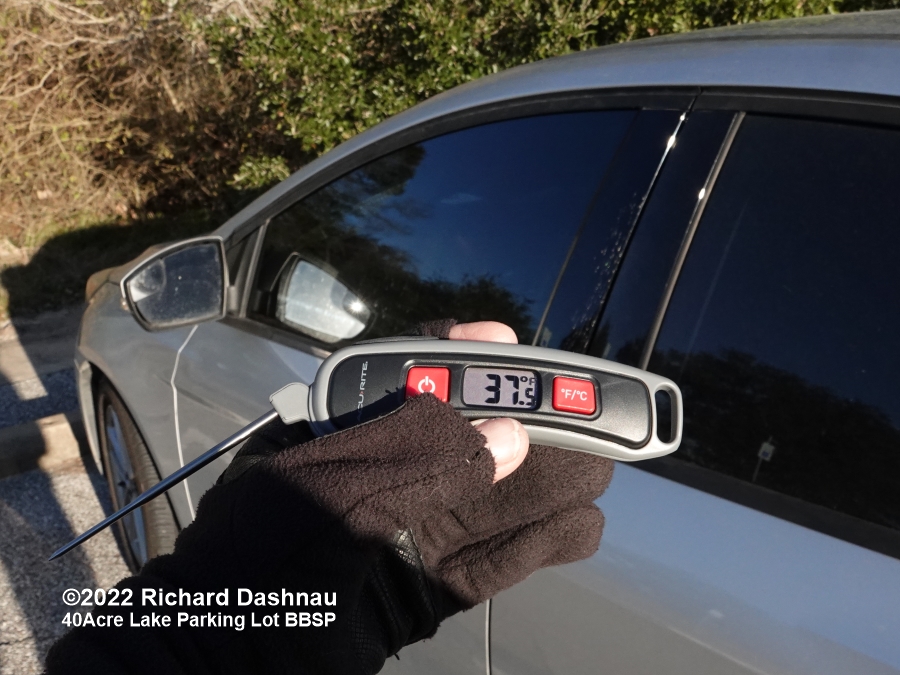
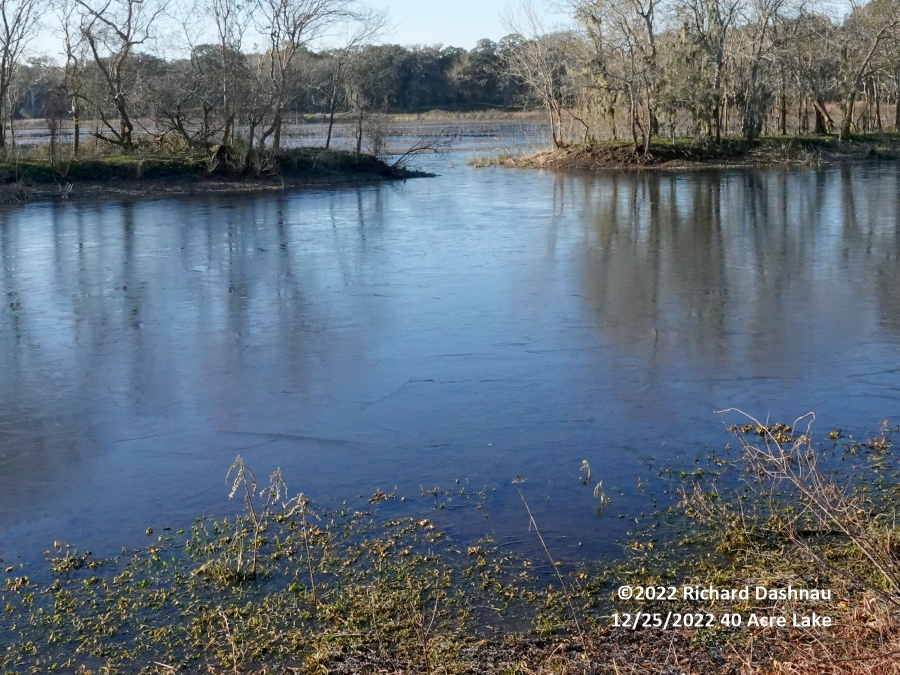

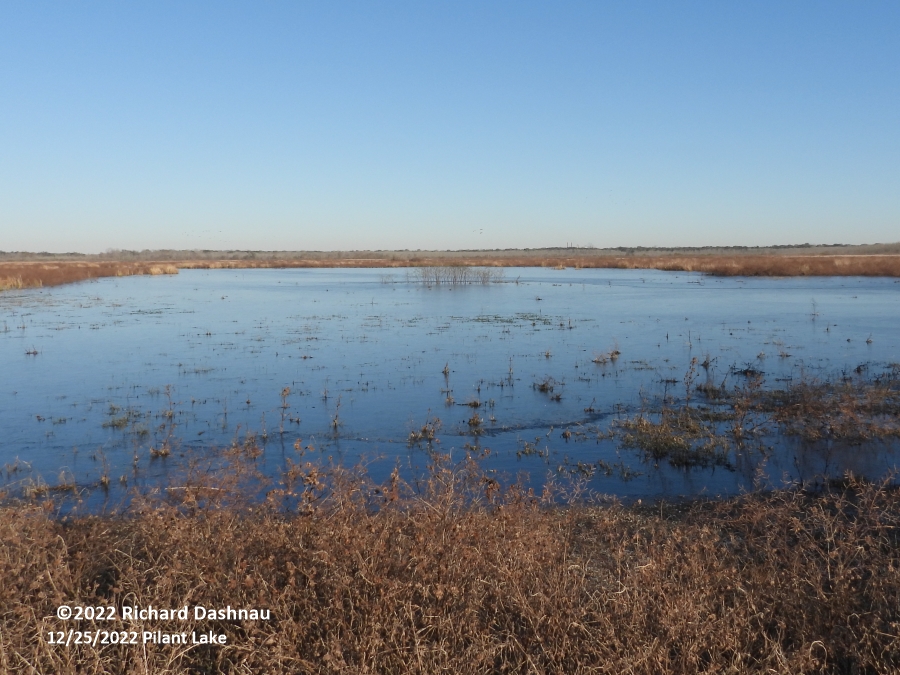
Even
though there was ice all around (and even further along the
South Side
of the Spillway Trail), Pilant Slough near the Observation
Tower was
unfrozen. I looked for the alligator mom who
had been there--and I
found her! About 8:50am, she was visible under the
water, with
just her nose exposed to the air.
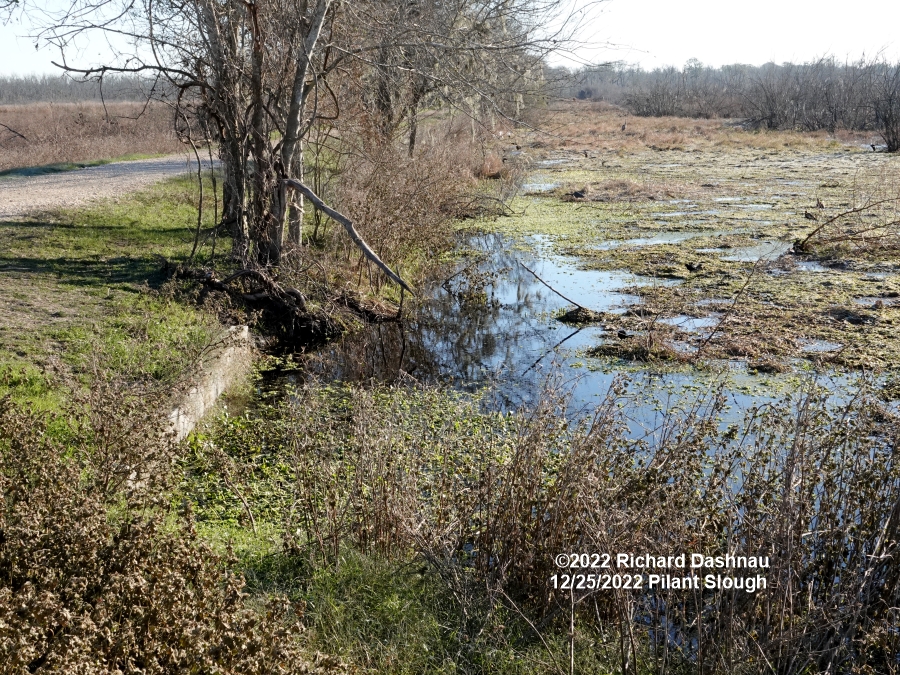
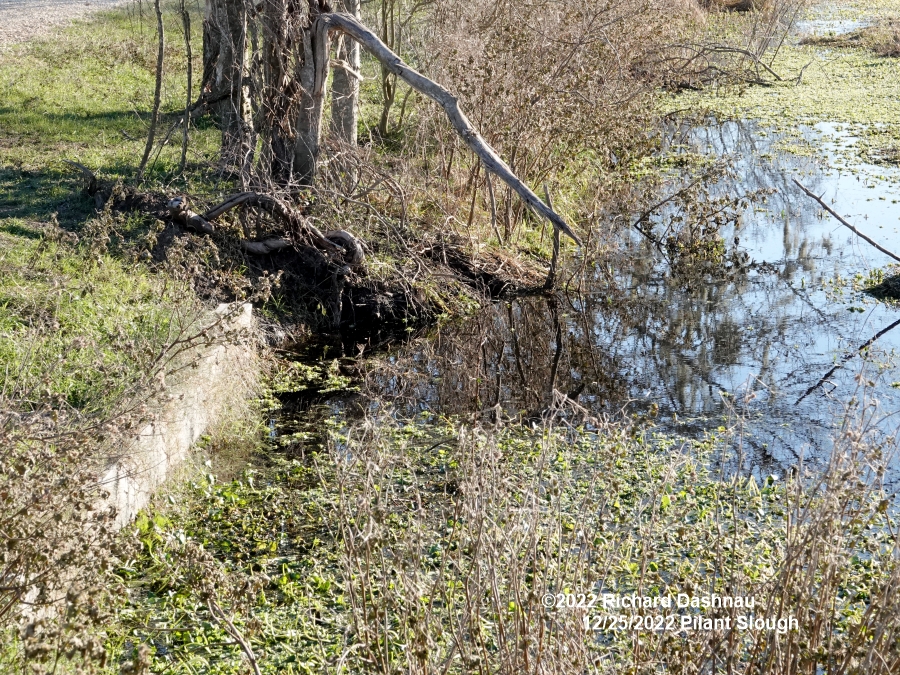
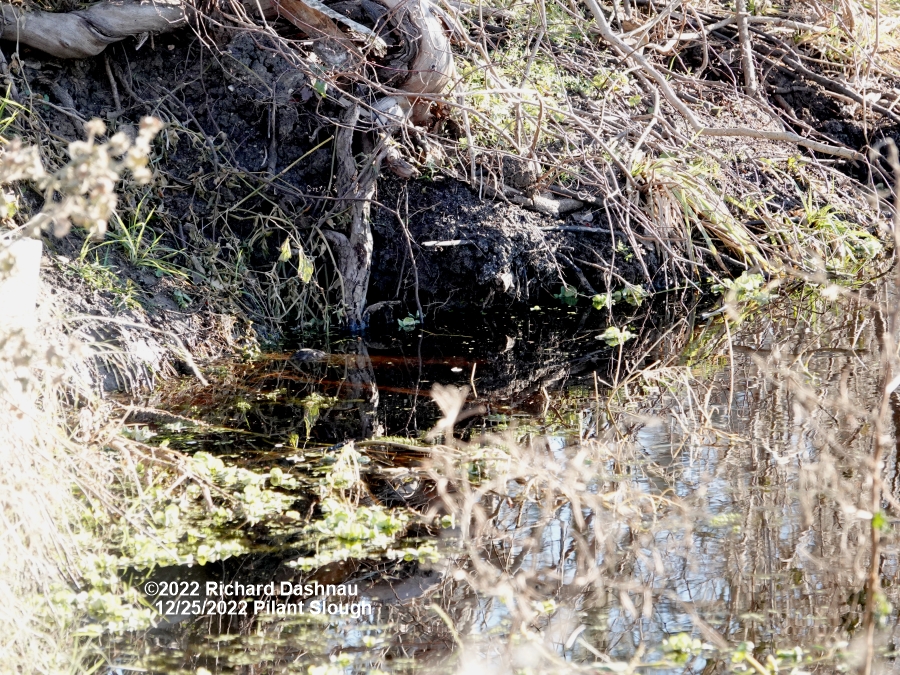
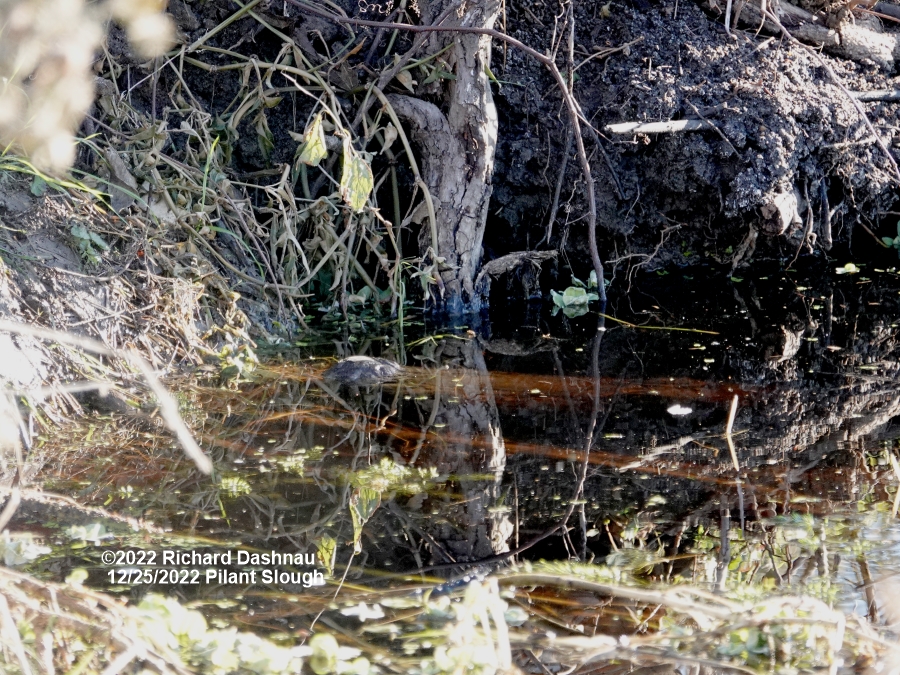
She
didn't move much, just went fully under water for a while and
then
exposed her nose (I didn't time her). As the morning
progressed, many
birds began foraging in the mats of floating
plants near the corner. Around 11 am, she rested her head on
the bank (I didn't think to get an air temperature reading).
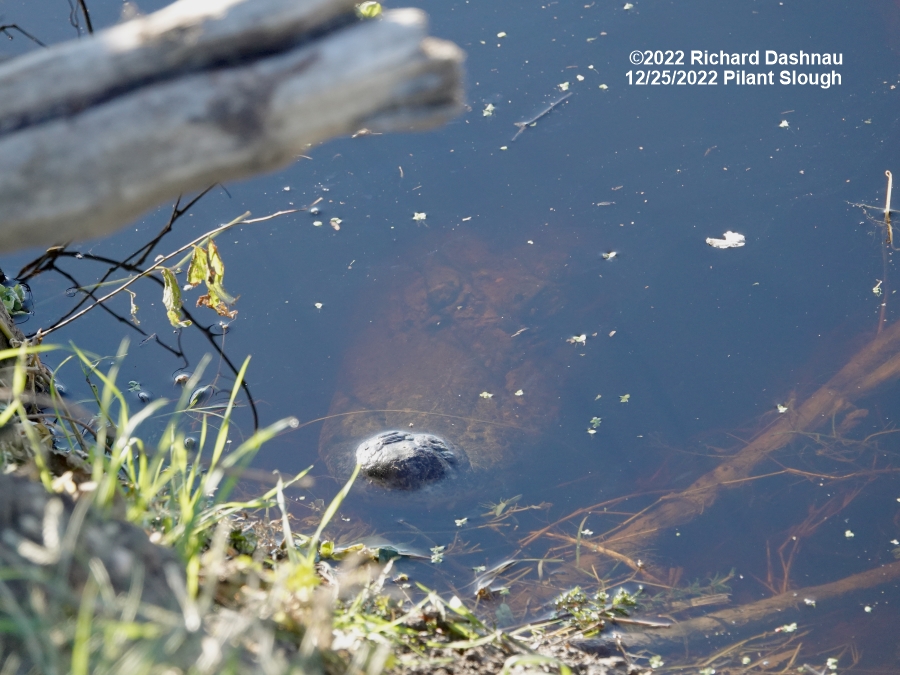

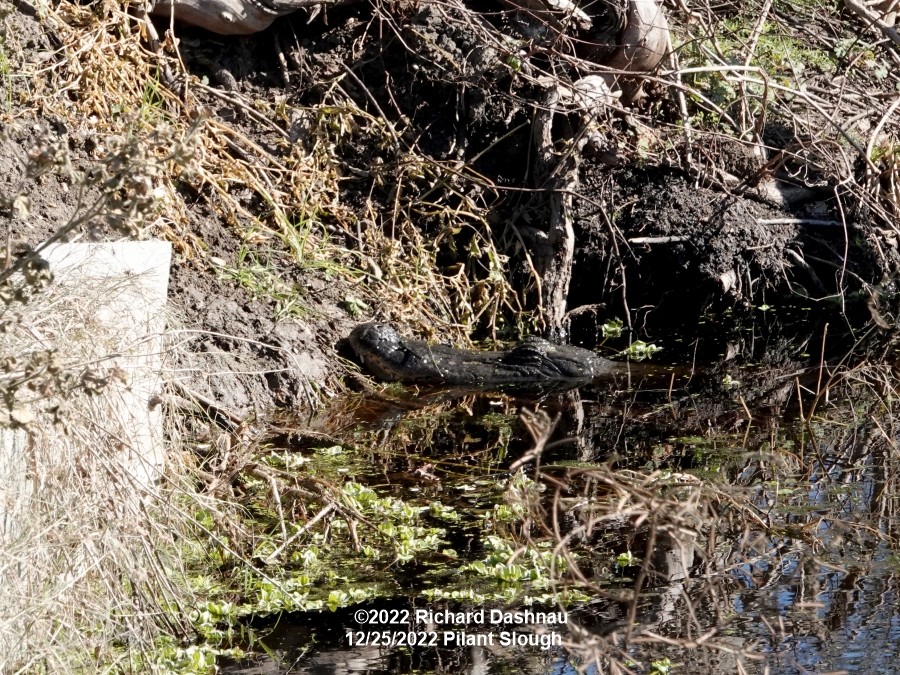
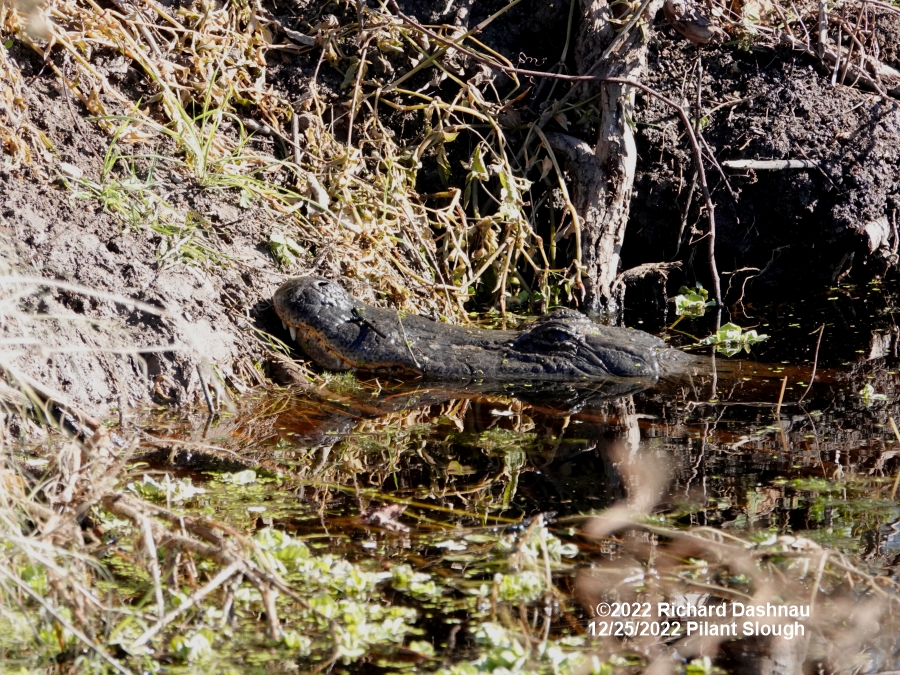
She
didn't move much, just went fully under water for a while and
then
exposed her nose (I didn't time her). As the morning
progressed, many
birds began foraging in the mats of floating
plants
near the corner. Around 12:30 pm, she climbed onto the bank
for a
while. She was back in the water at 3pm, but one of her babies
appeared at the surface.
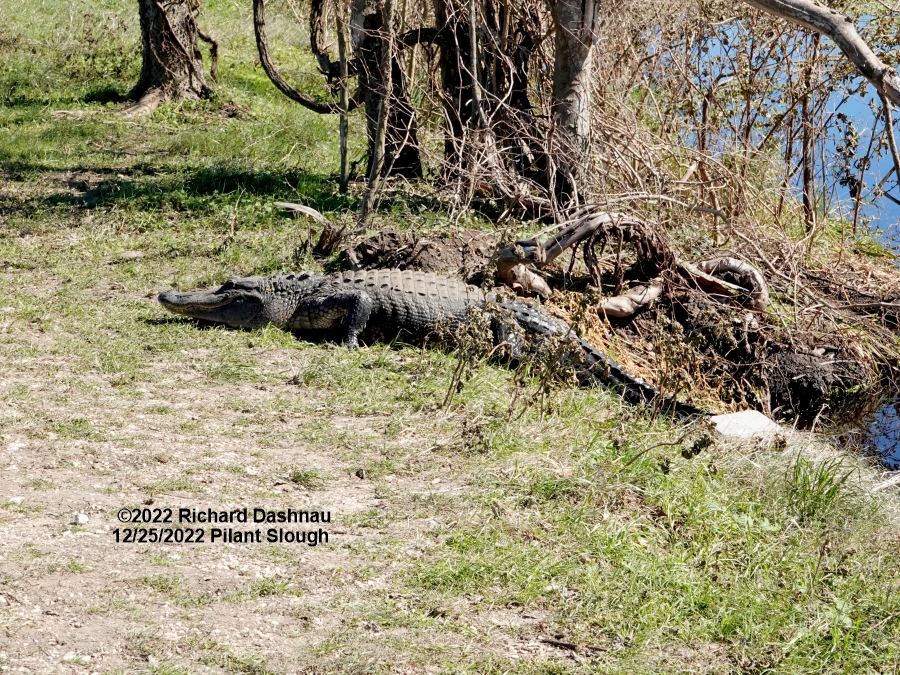
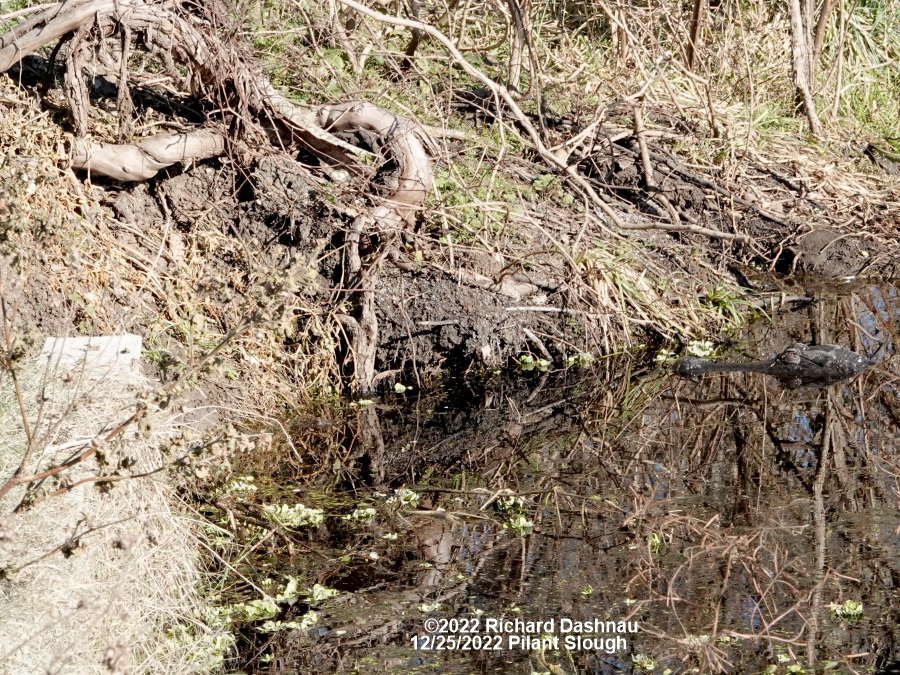
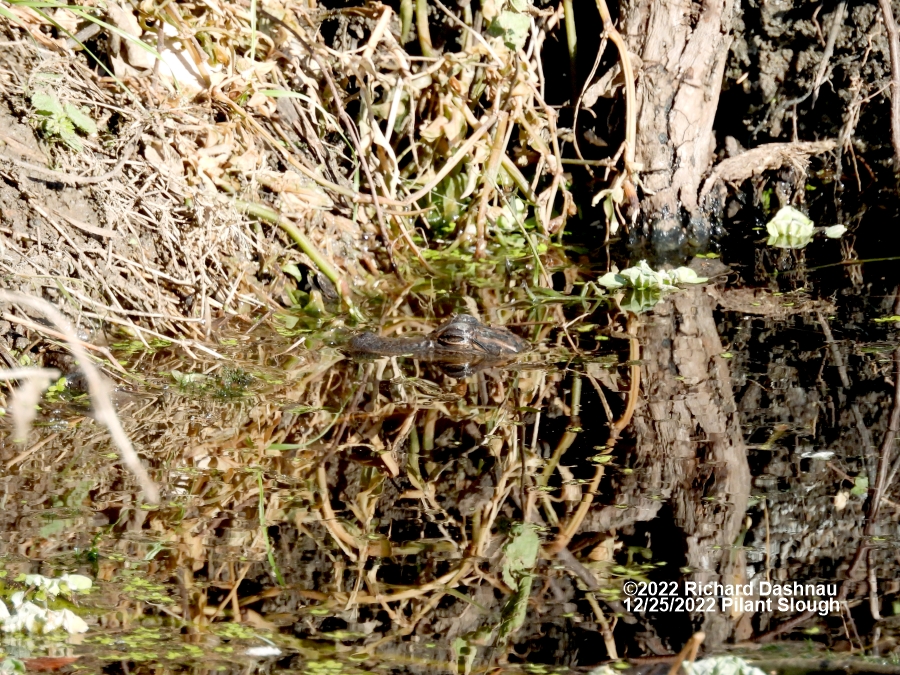
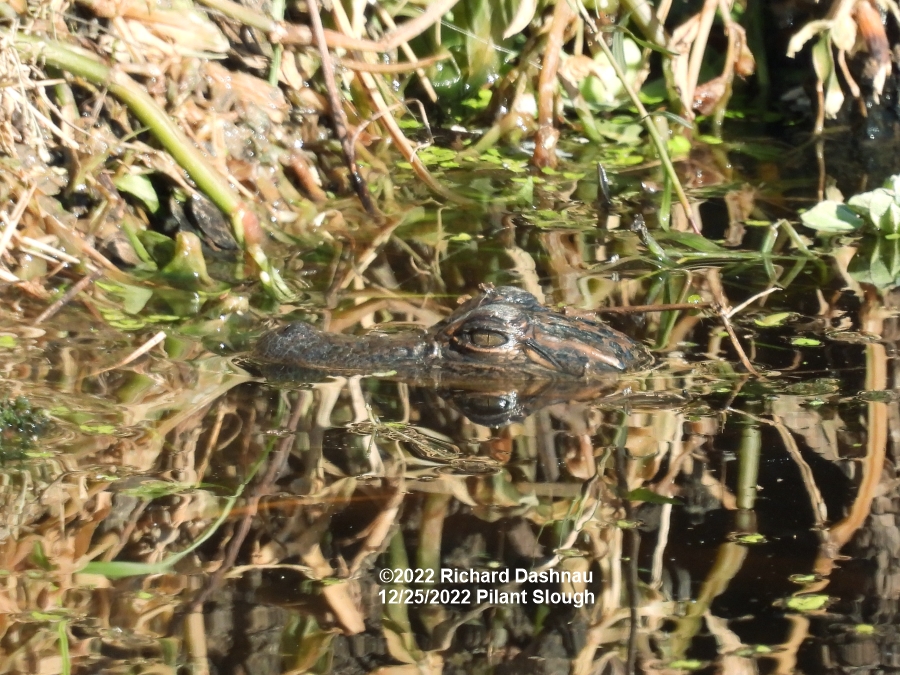
And,
this page shows
alligators at the park, on land, near various landmarks at the park.
Go back to my
main alligator page, Alligators
Go
back to my home page, Welcome
to rickubis.com
Go
back to the RICKUBISCAM
page.
Go
back to the See
the World
page.





























































































